Chapter 1 Continuity And Differentiability
Functions
Real Functions
Let R be the set of all real numbers, and let X and Y be any two nonempty subsets of R. Then, a rule f which associates to each x ∈ X, a unique real number f(x) ∈ Y is called a real function from X to Y and we write, f : X → Y.
f(x) is called the image of x or the value of the function at x. The sets X and Y are respectively known as the domain and the codomain of f.
Also, the set {f(x) : x ∈ X} is called the range of f.
Clearly, range (f) ⊆ Y.
However, if range (f) = Y, we say that f is an onto function: otherwise f is said to be an into function.
If two or more than two elements in X have the same image in Y then f is said to be a many-one function.
On the other hand, if different elements in X have different images in Y, we say that f is one-one.
Clearly, f is one-one ⇔ [f(x1) = f(x2) ⇒ x1 = x2].
A one-one onto function is called a one-to-one correspondence.
Remark 1 Sometimes a function is described only by a formula and the domain of the function is not explicitly stated. In such cases, the domain of the function is the set of all those real numbers for which the formula is meaningful.
Read and Learn More Class 12 Math Solutions
Remark 2 Usually the domain of a real function is an interval. For any two real numbers a and b, where a<b, we define
- closed interval [a, b] = {x ∈ R : a ≤ x ≤ b}
- open interval ]a, b[ = {x ∈ R : a < x < b}
- right-half open interval [a, b[ = {x ∈ R : a ≤ x < b}
- left-half open interval ]a, b] = {x ∈ R : a < x ≤ b}
- [a, ∞] = {x ∈ R : x > a}
- [a, ∞] = {x ∈ R : x ≥ a}
- [-∞, a] = {x ∈ R : x < a}
- [-∞, a] = {x ∈ R : x ≤ a}
Sometimes, we write, R = ]-∞, ∞[.
Some Important Functions
1. Constant Function Let c be a fixed real number. Then, the function defined by f(x) = c for all x ∈ R is called a constant function c.
Clearly, dom(f) = R and range (f) = {c}.
2. Identity Function The function defined by f(x) = x for all x ∈ R is called the identity function.
Clearly, its domain is R and its range is R.
3. Modulus Function The function defined by
\(f(x)=|x|=\left\{\begin{array}{r}x, \text { when } x \geq 0 \\
-x, \text { when } x<0
\end{array}\right.\)
is called the modulus function.
Since the modulus of every real number is a unique non-negative real number, so domf(x) = R.
Since | x | is either o or a positive real number, we have range (f) = {| x | : x ∈ R} = set of non-negative real numbers.
4. Reciprocal Function The function defined by f(x) = \(\frac{1}{x}\) is called the reciprocal function.
Clearly, \(\frac{1}{x}\) is not defined when x = 0.
∴ dom(f) = R – {0}.
Also, y = \(\frac{1}{x}\) ⇔ x = \(\frac{1}{y}\).
Clearly, x is defined for all real numbers y except when y = 0.
∴ range (f) = R – {0}.
5. Signum Function This function is defined by f(x) = \(\left\{\begin{array}{c}
\frac{|x|}{x}, \text { when } x \neq 0 \\
0, \text { when } x=0
\end{array}\right.\)
Thus, we have f(x) = \(\left\{\begin{array}{r}
1, \text { when } x>0 \\
0, \text { when } x=0 \\
-1, \text { when } x<0 .
\end{array}\right.\)
Clearly, its domain is R and range = {-1, 0, 1}.
6. Square-Root Function Let f(x) = +√x.
We know that the negative real numbers do not have real square roots. So, f(x) is not defined when x is a negative real number.
f(x) is not defined when x is a negative real number.
∴ dom(f) = set of all non-negative real numbers real numbers = [0, ∞[.
Clearly, range (f) = {+√x : x ∈ [0, ∞[} = [0, ∞[.
7. Step Function Or The Greatest Integer Function
If x ∈ R then [x] is defined as the greatest integer not exceeding x.
For example, we have
[2.01] = 2; [2.9] = 2; [-1.3] = -2; [3] = 3 and [-1] = -1, etc.
Now, if we consider f(x) = [x] then clearly for each x ∈ R, [x] is defined.
So dom(f) = R.
By definition, [x] is an integer.
So, range(f) = {[x] : x ∈ R} = set of all integers.
Example Find a set of all real numbers x such that [x] = 2.
Solution Clearly, for all x such that 2 ≤ x < 3, we have f(x) = [x] = 2.
∴ required set = {x ∈ R : 2 ≤ x < 3} = [2, 3[.
8. Smallest Integer Function (or Ceiling Function) For any real number x, we define ⌈x⌉ as the smallest integer greater than or equal to x.
For example,
⌈6.3⌉ = 7, ⌈7.01⌉ = 8, ⌈-6.1⌉ = -6, ⌈-2.9⌉ = -2, ⌈-3⌉ = -3, ⌈5⌉ = 5.
The function f : R → R : f(x) = ⌈x⌉, x ∈ R is called the smallest integer function or ceiling function.
Clearly, domain (f) = R and range (f) = I.
9. Polynomial Function A function of the formula
p(x) = a0xn+ a1xn-1 + a2xn-2 + … + an-1x+an,
where a0, a1, a2,…..,an-1,an are real numbers, a0 ≠ 0
and n is a non-negative integer, is called a polynomial function of degree n.
Polynomials of degree 1, 2, 3 and 4 are respectively called linear, quadratic, cubic and biquadratic polynomials.
Thus, (1) f(x) = ax + b, a ≠ 0, is a linear polynomial.
(2) f(x) = ax2 + bx + c, a ≠ 0, is a quadratic polynomial.
(3) f(x) = ax3 + bx2 + cx + d, a ≠ 0, is a cubic polynomial.
10. Rational Function A function of the form f(x) = \(\frac{p(x)}{q(x)}\), where p(x) and q(x) are polynomials and a(x) ≠ 0, is called a rational function.
Thus, f(x) = \(\left(\frac{x^2+1}{x^3-2 x+5}\right)\) is a rational function, where x3 – 2x + 5 ≠ 0.
Graphs
Graph of a Function
For a given function f(x), the aggregate of the points (x, f(x)) is called the graph or the curve representing the function.
In practice, we plot some of the points and join them freehand to obtain the graph.
Example 1 Draw the graphs of the constant functions
1. f(x) = 2
2. f(x) = 0
3. f(x) = -2
Solution (1) When f(x) = 2 for all x ∈ R, some of the points on the graph may be taken as (0, 2), (-1, 2), (1,2) (-2, 2), (2,2), etc.
Joining these points, we obtain a line y = 2, drawn parallel to the x-axis at a distance of 2 units from it, as the required graph.
Similarly,
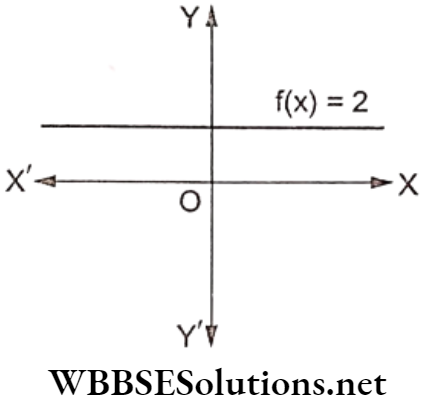
(2) the graph of the function f(x) = 0 is the line y = 0, i.e., the x-axis.
(3) The graph of the function f(x) = -2 is the line y = -2, drawn parallel to the x-axis at a distance of 2 units below the x-axis.
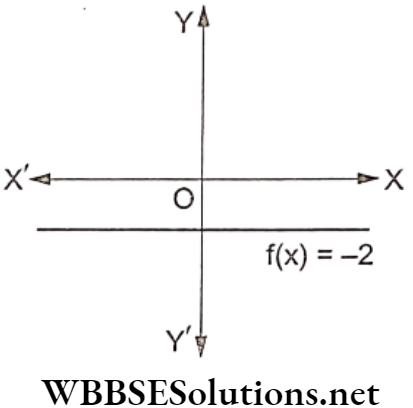
Example 2 Draw the graphs of the linear functions
(1) f(x) = 1-x
(2) f(x) = 2x + 1
Solution (1) When f(x) = 1-x, some of the points on the graph are (0, 1), (1,0), (2,-1), (-1, 2) etc.
Joining these points, we get a line as the graph of the function.
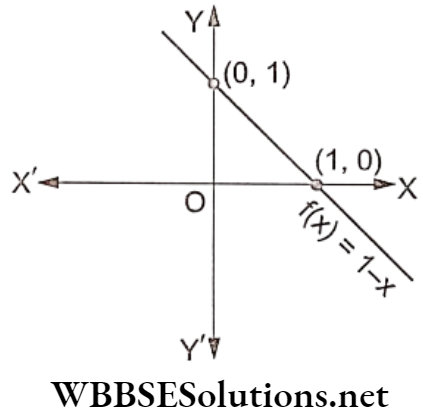
(2) Let f(x) = 2x+1.
Some of the points on the graph are (0,1), (1,3), (-1,-1), (2,5) etc.
Joining these points, we obtain a line as the graph.
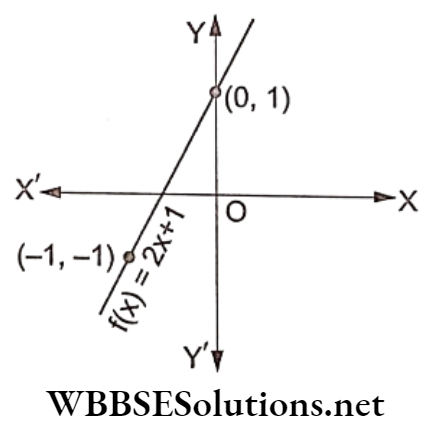
Remark The graph of a linear function is a straight line.
Example 3 Draw the graph of the identify function f(x) = x.
Solution f(x) = x is clearly a linear function whose graph must be a line. Plotting the points (0,0), (1,1), (-1,-1), etc., and joining them, we get the required graph.
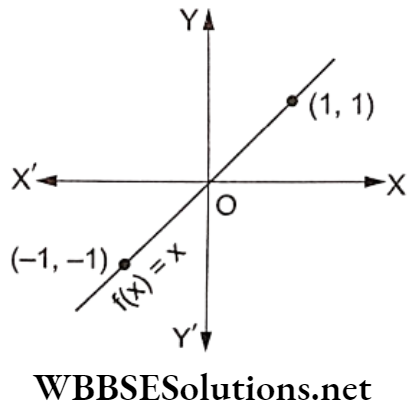
Example 4 Draw the graphs of the polynomial functions
(1) f(x) = x2
(2) f(x) = 1-x2
(3) f(X) = x3-x
Solution
(1) The function f(x) = x2 is a quadratic function. Some of the points on the graph are (0,0), (1,1), (-1, 1), (-2, 4), (2,4), (-3, 9), (3,9) etc.
Joining these points, we get a parabola as the graph.
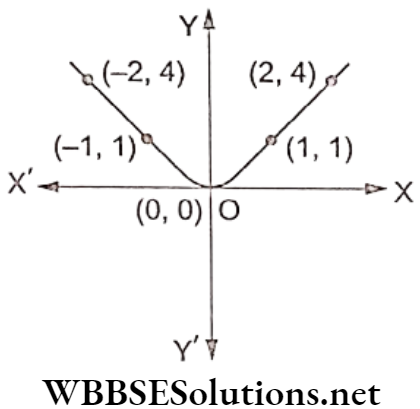
(2) f(x) = 1-x2 is also a quadratic function. Some of the points on the graph are (0,1), (1,0), (-1,0), (2,-3), (-2,-3), (-3,-8), (3,-8), etc.
Joining these points, we obtain a parabola as its graph.
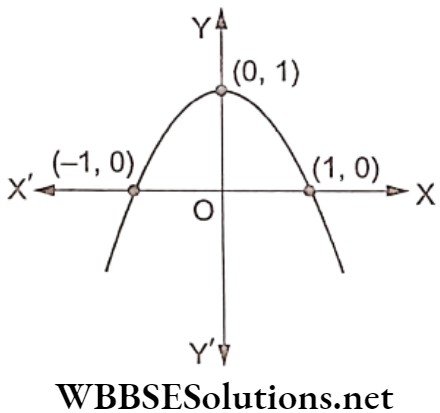
(3) Let f(x) = x3 – x.
This is a cubic function.
Some of the points on the graph are (0,0), (-1,0), (1,0), (-0.5, 0.375), (0.5, -0.375), (2,6), (-2,-6), etc.
Joining these points, we obtain the required graph.
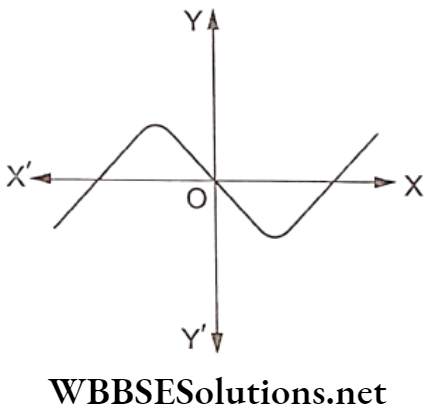
Remark It may be observed here that whenever (x,y) is a point on the graph then (-x,-y) is also a point on the graph. So, the graph is symmetrical about the origin.
This is an important property possessed by the graph of an odd function.
Example 5 Draw the graph of the modulus function f(x) = | x |.
Solution
f(x) = | x | = \(\left\{\begin{array}{r}
x \text { when } x \geq 0 \\
-x \text { when } x<0
\end{array}\right.\)
Some of the points on the graph are (0,0), (-1,1), (-2,2), (1,1), (2,2), etc.
Joining these points, we get the required graph.
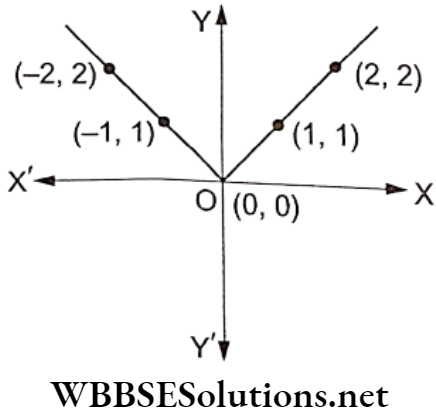
Remark It may be observed here that whenever (x,y) is a point on the graph, then (-x,y) is also a point of it. Thus, the graph is symmetrical about the y-axis. This is an important property possessed by the graphs of even functions.
Example 6 Draw the graph of the reciprocal function f(x) = \(\frac{1}{x}\).
Solution
Clearly, f(x) = \(\frac{1}{x}\) is not defined at x = 0. Some points on the graph are (1,1), (-1,-1), (1\2,2), (2,1/2), (-1/2,-2), (-2,-1/2), (1/3,3), (-1/3,-3), (3,1/3), etc.
Joining these points, we get the required graph. Since f(x) = \(\frac{1}{x}\) is an odd function, it is symmetrical about the origin.
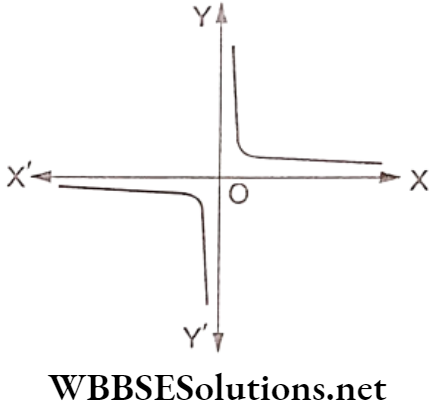
Example 7 Draw the graph of the square-root function f(x) = √x.
Solution
Let f be a real-valued function which associates to each non-negative real number x, its non-negative square root.
The, f: R0+→ R0+ : f(x) = √x, is called the square-root function.
Domain f(x) = R0+, and range (f) = R0+.
Some of the points on the graph are (0,0), (1,1), (2, 1.4), (3, 1.7), (4, 2), (5, 2.2), etc. Joining these points, we get the required graph.
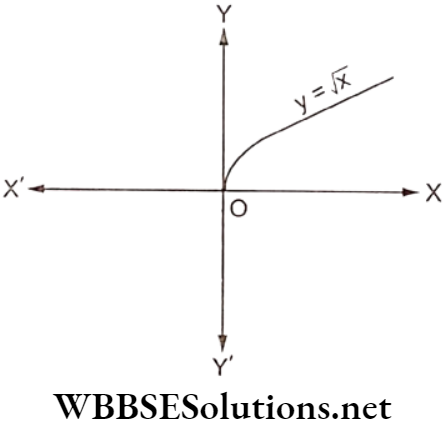
Example 8 Draw the graph of the rational function f(x) = \(\frac{x^2-1}{x-1}\).
Solution
Let f(x) = \(\frac{x^2-1}{x-1}\).
Now, f(1) = \(\frac{0}{0}\), which is meaningless.
So, the function is not defined at x = 1.
Also, when x ≠ 1, we have
f(x) = \(\left(\frac{x^2-1}{x-1}\right)\) = (x+1).
This being a linear function, its graph is a straight line.
Some of the points on the graph are (0,1), (-1,0), (2,3), (3,4), (-2,-1), (-3,-2), etc.
Joining these points, we obtain the required graph. Clearly, the point (1,2) does not lie on the graph. So, it is a broken graph, and we shall say that the given function is discontinous at x = 1.
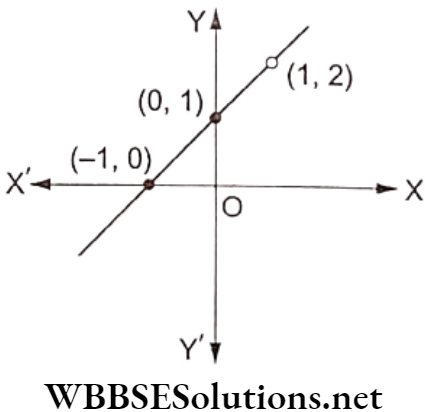
Example 9 Draw the graph of the step function f(x) = [x].
Solution
As the definition of the function indicates, for all x such that -2 ≤ x < -1,
we have f(x) = -2; for all x such that -1 ≤ x < 0,
We have f(x) = -1; for all x such that 0 ≤ x < 1,
we have f(x) = 0′ for all x such that 1 ≤ x < 2, we have f(x) = 1, and so on,
i.e., f(x) = \(\left[\begin{array}{c}
-2 \text { when } x \in[-2,-1[ \\
-1 \text { when } x \in[-1,0[ \\
0 \text { when } x \in[0,1[ \\
1 \text { when } x \in[1,2[ \\
\text { and so on. }
\end{array}\right.\)
![Class 12 Maths Continuity And Differentiability f(x) = [x]](https://wbbsesolutions.net/wp-content/uploads/2023/10/Class-12-Maths-Continuity-And-Differentiability-fx-x-1.png)
Clearly, the function jumps at the points (-1,-2), (0, -1), (1,0), (2,1), etc.
In other words, the given function is discontinuous at each integral value of x.
Example 10 Draw the graph of the smallest integer function f(x) = ⌈x⌉.
Solution
As the definition of the function suggest,
for all x such that -3 ≤ x ≤ -2, we have f(x) = -2;
for all x such that -2 < x ≤ -1, we have f(x) = -1;
for all x such that -1 < x ≤ 0, we have f(x) = 0;
for all x such that 0 < x ≤ 1, we have f(x) = 1; and so on.
i.e., f(x) = \(\left[\begin{array}{c}
-2 \text { when } x \in]-3,-2] \\
-1 \text { when } x \in]-2,-1] \\
0 \text { when } x \in]-1,0] \\
1 \text { when } x \in] 0,1] \\
2 \text { when } x \in] 1,2] \\
3 \text { when } x \in] 2,3] \\
\text { and so on. }
\end{array}\right.\)
![Class 12 Maths Continuity And Differentiability f(x) = [x]1](https://wbbsesolutions.net/wp-content/uploads/2023/10/Class-12-Maths-Continuity-And-Differentiability-fx-x1-1.png)
Plotting these points, we can get the required graph. The function jumps at the points (-2, -1), (-1, 0), (0,1), (1,2) etc., or is discontinuous at each integral value of x.
Example 11 Draw the graph of the signum function f(x) = \(\left\{\begin{array}{c}
\frac{|x|}{x} \text { when } x \neq 0 \\
0 \quad \text { when } x=0 .
\end{array}\right.\)
Solution
Clearly, (0,0) is a point on the graph. Now, when x > 0, we have | x | = x, and so in this case, we have, f(x) = 1, i.e., f(x) = 1 for all values of x > 0.
And, when x < 0, we have | x | = -x and therefore,
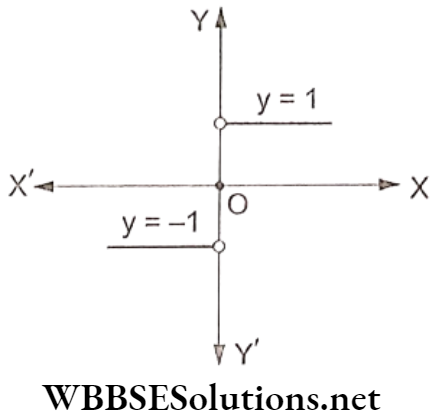
f(x) = -1 for all values of x < 0.
Hence the graph may be drawn, as shown in the adjoining figure.
Clearly, the function is broken (i.e., it is discontinuous) at each of the points x = -1,0 and 1.
Example 12 Draw the graph of the function f(x) = \(\left\{\begin{array}{l}
x^2, \text { when } x<0 \\
x, \text { when } 0 \leq x \leq 1 \\
1 / x, \text { when } 1 \leq x<\infty .
\end{array}\right.\)
Solution
Here, the graph consists of three parts. Some of the points of the graph are (-3,9), (-2,4), (-1,1), (0,0), (\(\frac{1}{2}\), \(\frac{1}{2}\)) , (\(\frac{3}{4}\), \(\frac{3}{4}\)), (1,1), (2,\(\frac{1}{2}\)), (3,\(\frac{1}{3}\)), etc.
And, the graph may now be drawn, as shown in the adjoining figure.
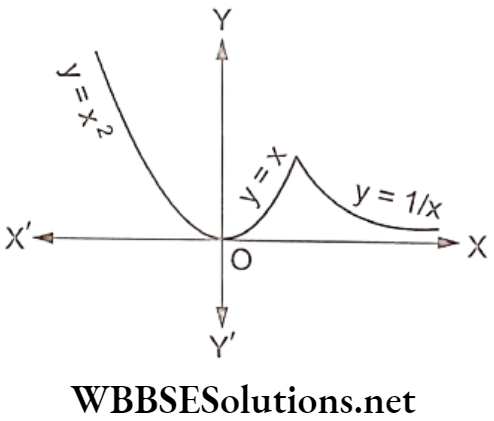
Example 13 Draw the graph of the function f(x) = | x | + | x-1 |.
Solution
Let us consider the following cases.
Case 1 When x < 0
In this case, (x-1) < 0.
∴ |x| = -x and | x-1 | = -(x-1) = 1 – x.
Consequently, | x | + | x-1 | = – x + 1 – x = 1 – 2x.
Case 2 When 0 ≤ x ≤ 1
In this case, | x | = x and | x-1 | = -(x-1) = 1-x.
∴ | x | + | x-1 | = x + 1 – x = 1.
Case 3 When x > 1
In this case, | x | = x and | x-1 | = x + (x-1) = (2x-1).
Thus, we may define the above function as
\(f(x)=\left\{\begin{array}{cl}1-2 x, & \text { when } x<0 \\
1, & \text { when } 0 \leq x \leq 1 \\
2 x-1, & \text { when } x>1
\end{array}\right.\)
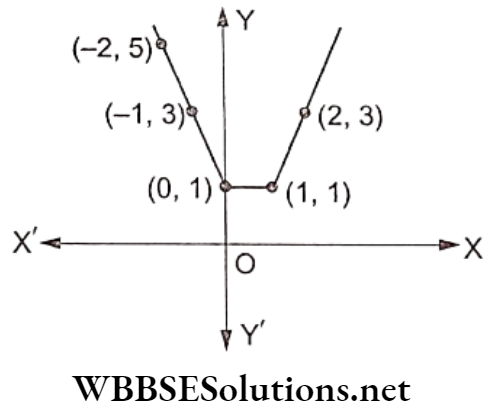
So, we have
(1) a linear function 1-2x when x < 0;
(2) a constant function 1 when 0 ≤ x ≤ 1;
(3) a linear function 2x-1 when x > 1.
The corresponding points on these parts of the graph are (-1,3), (-2,5), (0,1), (1,1), (2,3), (3,5), etc.
Joining these points, we obtain the graph as shown.
Example 14 Draw the graph of the exponential function:
(1) f(x) = 2x
(2) f(x) = \(\left(\frac{1}{3}\right)^x\)
Solution
(1) Let f(x) = 2x.
Some of the points on the graph are
(0,1), (1,2), (2,4), (3,8), \(\left(-1, \frac{1}{2}\right)\), \(\left(-2, \frac{1}{4}\right)\), \(\left(-3, \frac{1}{8}\right)\), etc.
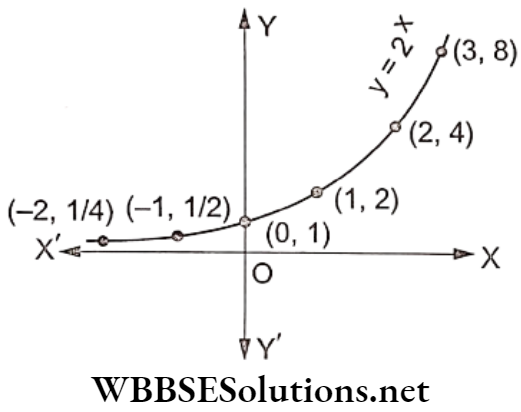
And so the graph takes the form, shown in the adjoining figure.
It may be observed here that the given function is strictly increasing. Also, as the value of x decreases, the corresponding value of the function decreases, and therefore, on the left-hand side of the y-axis, the curve comes closer and closer to the x-axis.
This is the case of the exponential function ax, where a > 1.
(2) Let f(x) = \(\left(\frac{1}{3}\right)^x\)
Some of the points on the graph are (-2,9), (-1,3), (0,1), \(\left(1, \frac{1}{3}\right)\), \(\left(2, \frac{1}{9}\right)\), etc.
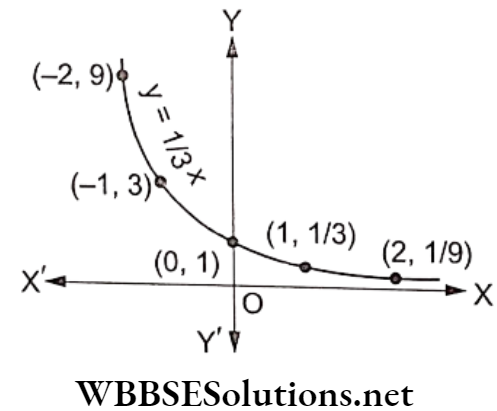
Joining these points, we obtain the graph as shown. It follows from the graph that the given function is strictly decreasing.
On the RHS of the y-axis, the curve comes closer and closer to the x-axis.
Remark This is the case of the exponential function ax, where 0 < a < 1.
Example 15 Draw the graphs of the logarithmic functions
(1) logax, when a > 1
(2) logax, when 0 < a < 1
Solution
(1) We know that when a > 1, the function ax is strictly increasing, i.e., different values of x give different values of ax. Also, the range of this function is R. So, the function f(x) = ax is one-one onto and therefore invertible.
Its graph is of the form shown in the adjoining figure. The graph of the function g(x) = logax x is the reflection of the graph of f(x) = ax in the line y = x.
It may be noted that the graph passes through (1,0).
(2) We know that when 0 < a < 1, the function ax is strictly decreasing, i.e., different values of x give different values of ax. So, the function is one-one. Also, its range is R. So, it is onto. Thus, the function ax is invertible.
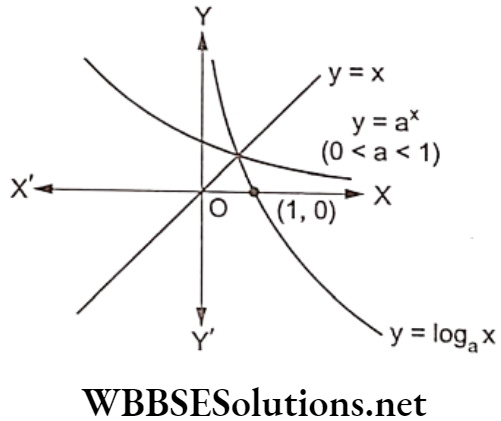
Its inverse is the log function reflected by the line y = x, as shown. The graph clearly passes through (1,0).
Example 16 On the same scale draw the graphs of ex and logex.
Solution
Since e lies between 2 and 3, it follows that e > 1. So, it is a particular case of ax, where a > 1. The fucntion ex is strictly increasing. Also, its range is R. So, the function is one-one onto and therefore invertible.
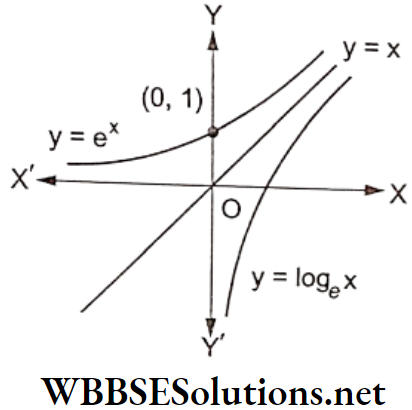
The graph passes through the point (0,1) and comes closer and closer to the x-axis and the values of x decrease. Thus, the graph of ex may be drawn as shown in the figure. Its reflection in the line y = x gives the graph of logex.
Graphs of Trignometric Functions
1. Graph Of A Sine Function We know that a sine function is periodic with period 2π. So, we have to sketch the graph in the interval [0,2π] and then we may complete the graph by repeating it over intervals, each of length 2π. We first draw it in the interval \(\left[0, \frac{\pi}{2}\right]\). We know that it is strictly increasing in this interval. Also, we may use the table, given below.

Thus, we may draw the graph in the interval \(\left[0, \frac{\pi}{2}\right]\).
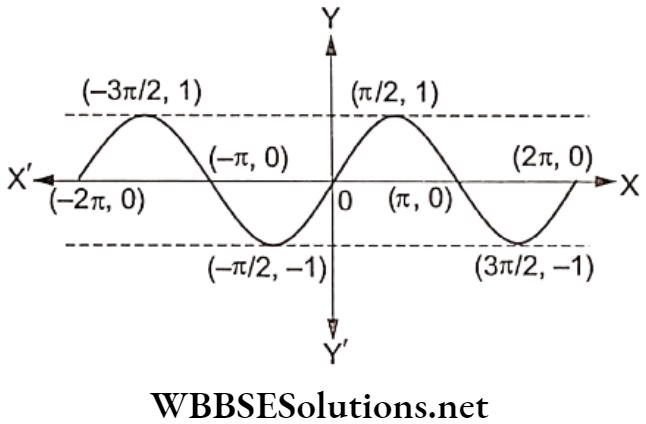
Now, we know that sin(π-x) = sin x. So we may get some other values of the function in the interval \(\left[\frac{\pi}{2}, \pi\right]\). Moreover, the function is strictly decreasing in this interval. Thus, we may draw it in the interval \(\left[\frac{\pi}{2}, \pi\right]\). Finally, we draw it in (π, 2π), using the fact that sin (π+x) = -sin x.
The graph may be completed now by making repetitions over each interval of length 2π.
2. Graph Of A Cosine Function We know that a cosine function is periodic with period 2π. By making use of the table given below, we may first draw it in the interval \(\left[0, \frac{\pi}{2}\right]\), keeping in view that it is strictly decreasing in this interval.

Now, cos (π-x) = -cos x, so, we may draw the graph in the interval [π/2, π]. It is strictly decreasing in this interval also. Further, making use of cos(π+x) = cos x, we may draw the graph form π to 2π, as shown in the figure.
The graph may now be completed by making repetitions over each interval of length 2π.
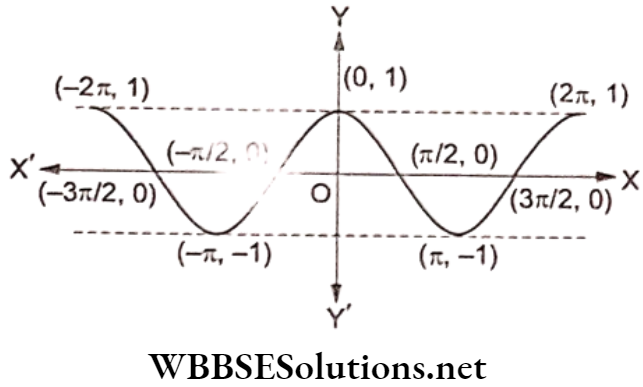
3. Graph Of A Tangent Function We know that a tangent function is a periodic function with period π. Therefore, it is enough to draw the graph over an interval of length π. The complete graph then consists of infinitely many repetitions of the same to the let as well as to the right.
Since tan(-x) = – tanx, therefore, if (x, tan x) is any point on the graph then (-x, -tan x) is also a point on the graph. Thus, we can say that the graph of y = tan x is symmetrical in opposite quadrants.
Some of the values of the function are given below:

The graph may thus be drawn as shown below.
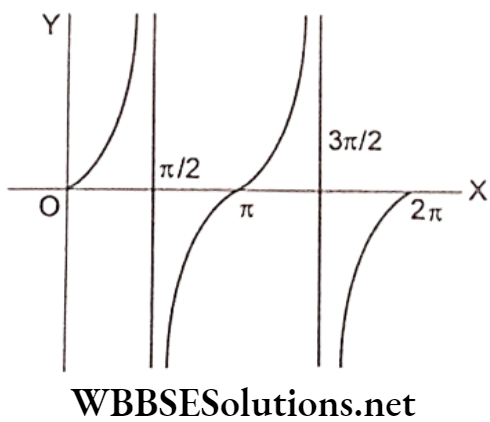
Similarly, the graphs of cosec x, sec x and cot x may be drawn.
Continuity
Continuity At A Point A real function f(x) is said to be continuous at a point a of its domain if \(\lim _{x \rightarrow a} f(x)\) exists and equals f(a).
Thus, f(x) is continuous at x = a if \(\lim _{x \rightarrow a^{+}} f(x)=\lim _{x \rightarrow a^{-}} f(x)=f(a) .\)
If f(x) is not continuous at a point, it is said to be discontinous at that point.
Remark f(x) is discontinuous at x = a in each of the following cases:
(1) f(a) is not defined
(2) \(\lim _{x \rightarrow a} f(x)\) does not exist
(3) \(\lim _{x \rightarrow a} f(x) \neq f(a)\) {removable discontinuity}
Geometric Idea of Continuity
Example 1 Consider the function: f(x) = \(\left\{\begin{array}{l}
1, \text { if } x \neq 0 \\
2, \text { if } x=0 .
\end{array}\right.\)
The above function is clearly defined for every real value of x.
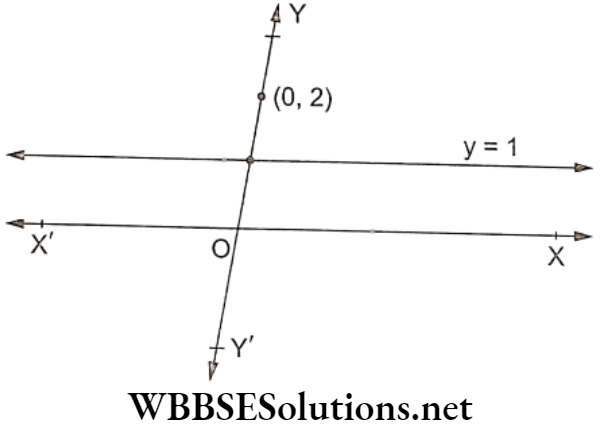
We have, f(0) = 2.
\(\lim _{x \rightarrow 0+} f(x)=\lim _{h \rightarrow 0} f(0+h)=\lim _{h \rightarrow 0} f(h)=1\).
\(\lim _{x \rightarrow 0-} f(x)=\lim _{h \rightarrow 0} f(0-h)=\lim _{h \rightarrow 0} f(-h)=1\).
∴ \(\lim _{x \rightarrow 0+} f(x)=\lim _{h \rightarrow 0-} f(x)=1 \text {. So, } \lim _{x \rightarrow 0} f(x)=1\).
Thus, \(\lim _{x \rightarrow a} f(x) \neq f(0)\).
If we draw the graph of the given function, we note that we cannot draw the graph without lifting the pen. We have to lift the pen at x=0.
So, the given function is discontinuous at x = 0.
Example 2 Consider the function: f(x) = \(\begin{cases}x+2, & \text { if } x \leq 1 \\ x-2, & \text { if } x>1\end{cases}\).
The given function is defined at all points of the real line.
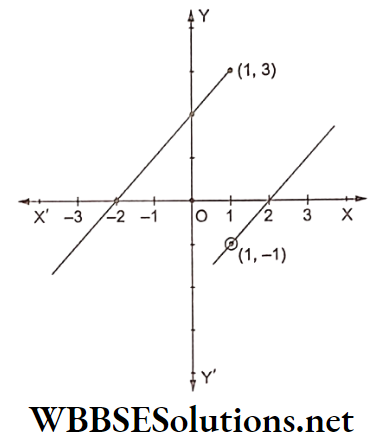
We have f(1) = (1 + 2) = 3.
\(\lim _{x \rightarrow 1+} f(x)=\lim _{h \rightarrow 0} f(1+h)=\lim _{h \rightarrow 0} f(1+h-2)=\lim _{h \rightarrow 0} f(h-1)=-1\).
\(\lim _{x \rightarrow 1-} f(x)=\lim _{h \rightarrow 0} f(1-h)=\lim _{h \rightarrow 0} f(1-h+2)=\lim _{h \rightarrow 0} f(3-h)=3\).
∴ \(\lim _{x \rightarrow 1+} f(x) \neq \lim _{x \rightarrow 1-} f(x) \text { and so } \lim _{x \rightarrow 1} f(x)\) does not exist.
If we draw the graph of the above function, we note that we cannot draw the graph without lifting the pen. We have to lift the pen at x = 1.
So, the given function is discontinuous at x = 1.
Solved Examples
Example 1 Show that f(x) = x3 is continuous at x = 2.
Solution
f(x) = x3
We have f(2) = 23 = 8;
\(\lim _{x \rightarrow 2+} f(x)=\lim _{h \rightarrow 0}(2+h)^3=\lim _{h \rightarrow 0}\left(8+h^3+12 h+6 h^2\right)=8\);
\(\lim _{x \rightarrow 2-} f(x)=\lim _{h \rightarrow 0}(2-h)^3=\lim _{h \rightarrow 0}\left(8-h^3-12 h+6 h^2\right)=8\).
∴ \(\lim _{x \rightarrow 2+} f(x)=\lim _{x \rightarrow 2-} f(x)=f(2)\).
Hence, f(x) is continuous at x = 2.
Example 2 Show that f(x) = [x] is not continuous at x = n, where n is an integer.
Solution
We have f(n) = [n] = n;
\(\lim _{x \rightarrow n+} f(x)=\lim _{h \rightarrow 0} f(n+h)=\lim _{h \rightarrow 0}[n+h]=n\) {∵ [n+h] = n};
\(\lim _{x \rightarrow n-} f(x)=\lim _{h \rightarrow 0} f(n-h)=\lim _{h \rightarrow 0}[n-h]=(n-1)\) {∵ [n-h] = (n-1)}.
Thus, \(\lim _{x \rightarrow n+} f(x) \neq \lim _{x \rightarrow n-} f(x)\) and therefore, \(\lim _{x \rightarrow n} f(x)\) does not exist.
Hence, f(x) is discontinuous at x = n.
Example 3 Show that the function f(x) = \(\left\{\begin{array}{l}
x, \text { if } x \text { is an integer; } \\
0, \text { if } x \text { is not an integer }
\end{array}\right.\)
Solution
Let x = n, where n is an integer. Then f(n) = n;
\(\lim _{x \rightarrow n+} f(x)=\lim _{h \rightarrow 0} f(n+h)=0\)[∴ (n + h) is not an integer ⇒ f(n+h) = 0];
and \(\lim _{x \rightarrow n^{-}} f(x)=\lim _{h \rightarrow 0^{-}} f(n-h)=0\)
[∴ (n-h) is not an integer ⇒ f(n-h) = 0].
∴ \(\lim _{x \rightarrow n+} f(x)=\lim _{x \rightarrow n-} f(x)=0\)
So, \(\lim _{x \rightarrow n} f(x)=0 \neq f(n)\).
Hence, f(x) is discontinuous at x = n.
Example 4 Discuss the continuity of the function f(x) at x = 0, if
f(x) = \(\begin{cases}2 x-1, & x<0 \\ 2 x+1, & x \geq 0\end{cases}\).
Solution
Clearly, f(0) = (2 x 0 + 1) = 1.
\(\lim _{x \rightarrow 0+} f(x)=\lim _{h \rightarrow 0} f(0+h)\) = \(\lim _{h \rightarrow 0}[2(0+h)+1]=\lim _{h \rightarrow 0}(2 h+1)=1\).
\(\lim _{x \rightarrow 0-} f(x)=\lim _{h \rightarrow 0} f(0-h)\) = \(\lim _{h \rightarrow 0}[2(0+h)+1]=\lim _{h \rightarrow 0}(2 h+1)=1\).
Thus, \(\lim _{x \rightarrow 0+} f(x) \neq \lim _{x \rightarrow 0-} f(x)\) and therefore, \(\lim _{x \rightarrow 0} f(x)\) does not exist.
Hence, f(x) is discontinuous at x = 0.
Example 5 Show that the function f(x) = \(\left\{\begin{array}{r}
3 x-2, \text { when } x \leq 0 \\
x+1, \text { when } x>0
\end{array}\right.\) is discontinuous at x = 0.
Solution
We have, f(0) = (3 x 0 – 2) = -2.
\(\lim _{x \rightarrow 0+} f(x)=\lim _{h \rightarrow 0} f(0+h)\) = \(\lim _{h \rightarrow 0}(h+1)=1\).
\(\lim _{x \rightarrow 0^{-}} f(x)=\lim _{h \rightarrow 0} f(0-h)\) = \(\lim _{h \rightarrow 0}[3(-h)-2]=\lim _{h \rightarrow 0}(-3 h-2)=-2\).
∴ \(\lim _{x \rightarrow 0+} f(x) \neq \lim _{x \rightarrow 0-} f(x)\) and therefore, \(\lim _{x \rightarrow 0} f(x)\) does not exist.
Hence, f(x) is discontinuous at x = 0.
Example 6 Show that the function f(x) = \(\left\{\begin{array}{c}
\frac{x}{|x|}, \text { when } x \neq 0 \\
1, \text { when } x=0
\end{array}\right.\) is discontinuous at x = 0.
Solution
It is being given that f(0) = 1.
\(\lim _{x \rightarrow 0+} f(x)=\lim _{h \rightarrow 0} f(0+h)=\lim _{h \rightarrow 0} \frac{h}{|h|}=\lim _{h \rightarrow 0} \frac{h}{h}=1\).
\(\lim _{x \rightarrow 0-} f(x)=\lim _{h \rightarrow 0} f(0-h)=\lim _{h \rightarrow 0} \frac{-h}{|h|}=\lim _{h \rightarrow 0} \frac{-h}{h}=-1\).
∴ \(\lim _{x \rightarrow 0+} f(x) \neq \lim _{x \rightarrow 0-} f(x)\).
So, \(\lim _{x \rightarrow 0} f(x)\) does not exist.
Hence, f(x) is discontinuous at x = 0.
Example 7 Examine the continuity of the function f(x) = \(\left\{\begin{array}{cl}
\frac{|\sin x|}{x}, & x \neq 0 \\
1, & x=0 \text { at } x=0 .
\end{array}\right.\)
Solution
We have f(0) = 1.
\(\lim _{x \rightarrow 0+} f(x)=\lim _{h \rightarrow 0} f(0+h)\) = \(\lim _{h \rightarrow 0} \frac{|\sin (0+h)|}{(0+h)}=\lim _{h \rightarrow 0} \frac{|\sin h|}{h}=\lim _{h \rightarrow 0} \frac{\sin h}{h}=1\).
\(\lim _{x \rightarrow 0-} f(x)=\lim _{h \rightarrow 0} f(0-h)\)= \(\lim _{h \rightarrow 0} \frac{|\sin (-h)|}{-h}=\lim _{h \rightarrow 0} \frac{|-\sin h|}{-h}=\lim _{h \rightarrow 0} \frac{\sin h}{-h}=-1\).
∴ \(\lim _{x \rightarrow 0+} f(x) \neq \lim _{x \rightarrow 0-} f(x)\). So, \(\lim _{x \rightarrow 0} f(x)\) does not exist.
Hence, f(x) is discontinuous at x = 0.
Example 8 Show that the function f(x) = 2x – | x | is continuous at x = 0.
Solution
We have, f(0) = (2 x 0) – | 0 | = 0.
\(\lim _{x \rightarrow 0+} f(x)=\lim _{h \rightarrow 0} f(0+h)\)= \(\lim _{h \rightarrow 0}(2 h-|h|)=\lim _{h \rightarrow 0}(2 h-h)=\lim _{h \rightarrow 0} h=0\).
\(\lim _{x \rightarrow 0-} f(x)=\lim _{h \rightarrow 0} f(0-h)\)= \(\lim _{h \rightarrow 0}\{2(-h)-|-h|\}=\lim _{h \rightarrow 0}(-2 h-h)=\lim _{h
\rightarrow 0}(-3 h)=0\).
Thus, \(\lim _{x \rightarrow 0+} f(x)=\lim _{x \rightarrow 0-} f(x)=0 and therefore, \lim _{x \rightarrow 0} f(x)=0\).
∴ \(\lim _{x \rightarrow 0} f(x)=f(0)=0\).
Hence, f(x) is continuous at x = 0.
Examine 9 Let f(x) = \(\left\{\begin{aligned}
|x|+3, & \text { if } x \leq-3 \\
-2 x, & \text { if }-3<x<3 \\
6 x+2, & \text { if } x \geq 3 .
\end{aligned}\right.\) Show that f(x) is continuous at x = -3 but discontinuous at x = 3.
Solution
We have f(-3) = | 3 | + 3 = (3+3) = 6.
\(\lim _{x \rightarrow(-3)+} f(x)=\lim _{h \rightarrow 0} f(-3+h)\) = \(\lim _{h \rightarrow 0}\{-2(-3+h)\}=\lim _{h \rightarrow 0}(6-2 h)=6\).
\(\lim _{x \rightarrow(-3)-} f(x)=\lim _{h \rightarrow 0} f(-3-h)\) = \(\lim _{h \rightarrow 0}(|-3-h|+3)=\lim _{h \rightarrow 0}\{|-(3+h)|+3\}\)
= \(\lim _{h \rightarrow 0}\{(3+h)+3\}=6\).
∴ \(\lim _{x \rightarrow(-3)+} f(x)=\lim _{x \rightarrow(-3)-} f(x)=6\). So, \(\lim _{x \rightarrow(-3)} f(x)=6\).
Thus, \(\lim _{x \rightarrow(-3)} f(x)=f(-3)=6\).
Hence, f(x) is continuous at x = -3.
Now, f(3) = (6 x 3 + 2) = 20.
\(\lim _{x \rightarrow 3-} f(x)=\lim _{h \rightarrow 0} f(3-h)\)= \(\lim _{h \rightarrow 0}\{-2(3-h)\}=\lim _{h \rightarrow 0}(-6+2 h)=-6\).
Thus, \(f(3) \neq \lim _{x \rightarrow 3-} f(x)\).
Hence, f(x) is discontinuous at x = 3.
Example 10 Find the value of k for which
f(x) = \(\left\{\begin{array}{r}
k x+5, \text { when } x \leq 2 \\
x-1, \text { when } x>2
\end{array}\right.\) is continuous at x = 2.
Solution
We have, f(2) = (k x 2 + 5) = (2k + 5).
\(\lim _{x \rightarrow 2+} f(x)=\lim _{h \rightarrow 0} f(2+h)\)= \(\lim _{h \rightarrow 0}\{(2+h)-1\}=\lim _{h \rightarrow 0}(1+h)=1\).
\(\lim _{x \rightarrow 2-} f(x)=\lim _{h \rightarrow 0} f(2-h)\)= \(\lim _{h \rightarrow 0}\{k(2-h)+5\}=\lim _{h \rightarrow 0}\{(2 k+5)-k h\}=(2 k+5)\).
Now, \(\lim _{x \rightarrow 2} f(x)\) exists only when 2k + 5 = 1, i.e., when k = -2.
When k = -2, we have \(\lim _{x \rightarrow 2} f(x)=f(2)=1\).
Hence, f(x) is continuous at x = 2 when k = -2.
Example 11 If the following function f(x) is continuous at x = 0, find the value of k:
f(x) = \(\left\{\begin{aligned}
\frac{1-\cos 2 x}{2 x^2}, & x \neq 0 \\
k, & x=0
\end{aligned}\right.\)
Solution
We have, f(0) = k.
\(\lim _{x \rightarrow 0+} f(x)=\lim _{h \rightarrow 0} f(0+h)\)= \(\lim _{h \rightarrow 0} \frac{(1-\cos 2 h)}{2 h^2}=\lim _{h \rightarrow 0} \frac{2 \sin ^2 h}{2 h^2}=\lim _{h \rightarrow 0}\left(\frac{\sin h}{h}\right)^2\)
= \(\left\{\lim _{h \rightarrow 0}\left(\frac{\sin h}{h}\right)\right\}^2=(1)^2=1\).
\(\lim _{x \rightarrow 0-} f(x)=\lim _{h \rightarrow 0} f(0-h)\)= \(\lim _{h \rightarrow 0}\left\{\frac{1-\cos 2(-h)}{2(-h)^2}\right\}=\lim _{h \rightarrow 0} \frac{\{1-\cos (-2 h)\}}{2 h^2}\)
= \(\lim _{h \rightarrow 0} \frac{(1-\cos 2 h)}{2 h^2}=\lim _{h \rightarrow 0} \frac{2 \sin ^2 h}{2 h^2}=\lim _{h \rightarrow 0}\left(\frac{\sin h}{h}\right)^2\)
= \(\left\{\varliminf_{h \rightarrow 0} \frac{\sin h}{h}\right\}^2=1^2=1\).
Since f(x) is continuous at x = 0, we must have
f(0) = \(\lim _{x \rightarrow 0+} f(x)=\lim _{x \rightarrow 0-} f(x)\) ⇒ k = 1.
Example 12 For what value of k is the following function continuous at x = 0?
f(x) = \(\left\{\begin{aligned}
\frac{1-\cos 4 x}{8 x^2}, & x \neq 0 \\
k, & x=0
\end{aligned}\right.\)
Solution
We have, f(0) = k.
\(\lim _{x \rightarrow 0^{+}} f(x)=\lim _{h \rightarrow 0} f(0+h)\)= \(\lim _{h \rightarrow 0} \frac{(1-\cos 4 h)}{8 h^2}=\lim _{h \rightarrow 0} \frac{2 \sin ^2 2 h t}{8 h^2}=\lim _{h \rightarrow 0}\left(\frac{\sin 2 h}{2 h}\right)^2\)
= 12 = 1.
\(\lim _{x \rightarrow 0-} f(x)=\lim _{h \rightarrow 0} f(0-h)\)= \(\lim _{h \rightarrow 0} \frac{\{1-\cos 4(-h) \mid}{8(-h)^2}=\lim _{h \rightarrow 0} \frac{\{1-\cos (-4 h)\}}{8 h^2}=\lim _{h \rightarrow 0} \frac{(1-\cos 4 h)}{8 h^2}\)
[ ∵ cos(-θ) = cosθ]
= \(\lim _{h \rightarrow 0} \frac{2 \sin ^2 2 h}{8 h^2}=\lim _{h \rightarrow 0}\left(\frac{\sin 2 h}{2 h}\right)^2\)
= 12 = 1.
∴ \(\lim _{x \rightarrow 0} f(x)=1\).
For continuity at x = 0, we must have
\(f(0)=\lim _{x \rightarrow 0} f(x) \Rightarrow k=1\) [ ∵ \(f(0)=k \text { and } \lim _{x \rightarrow 0} f(x)=1\)].
Example 13 Given that
f(x) = \(\left\{\begin{array}{rr}
\frac{(1-\cos 4 x)}{x^2}, & \text { if } x<0 \\
a, & \text { if } x=0 \\
\frac{\sqrt{x}}{\sqrt{16+\sqrt{x}}-4}, & \text { if } x>0
\end{array}\right.\).
If f(x) is continuous at x = 0, find the value of a.
Solution
We have, f(0) = a.
\(\lim _{x \rightarrow 0^{+}} f(x)=\lim _{h \rightarrow 0} f(0+h)\)= \(\lim _{h \rightarrow 0}\left\{\frac{\sqrt{h}}{\sqrt{16+\sqrt{h}}-4}\right\}\)
= \(\lim _{h \rightarrow 0}\left\{\frac{\sqrt{h}}{\sqrt{16+\sqrt{h}}-4} \times \frac{\sqrt{16+\sqrt{h}}+4}{\sqrt{16+\sqrt{h}}+4}\right\}\)
= \(\lim _{h \rightarrow 0} \frac{\sqrt{h} \cdot\{\sqrt{16+\sqrt{h}}+4\}}{\{(16+\sqrt{h})-16\}}=\lim _{h \rightarrow 0} \frac{\sqrt{h} \cdot\{\sqrt{16+\sqrt{h}}+4\}}{\sqrt{h}}\)
= \(\lim _{h \rightarrow 0}\{\sqrt{16+\sqrt{h}}+4\}=(4+4)=8\)
\(\lim _{x \rightarrow 0-} f(x)=\lim _{h \rightarrow 0} f(0-h)=\lim _{h \rightarrow 0} f(-h)\)= \(\lim _{h \rightarrow 0} \frac{\{1-\cos 4(-h)\}}{(-h)^2}=\lim _{h \rightarrow 0} \frac{\{1-\cos (-4 h)\}}{h^2}\)
= \(\lim _{h \rightarrow 0} \frac{(1-\cos 4 h)}{h^2}=\lim _{h \rightarrow 0} \frac{2 \sin ^2 2 h}{h^2}\)
= \((2 \times 4) \cdot \lim _{h \rightarrow 0} \frac{\left(\sin ^2 2 h\right)}{(2 h)^2}=8 \cdot \lim _{h \rightarrow 0}\left(\frac{\sin 2 h}{2 h}\right)^2\)
= (8 x 12) = 8.
∴ \(\lim _{x \rightarrow 0+} f(x)=\lim _{x \rightarrow 0-} f(x)=8 \Rightarrow \lim _{x \rightarrow 0} f(x)=8\).
But, by continuity of f at x = 0, we have
\(\lim _{x \rightarrow 0} f(x)=f(0) \Rightarrow a=8\) [ ∵ \(f(0)=a \text { and } \lim _{x \rightarrow 0} f(x)=8\)].
Hence, a = 8.
Example 14 If the following function f(x) is continuous at x = 0, find the values of a,b and c.
f(x) = \(\left\{\begin{array}{cc}
\frac{\sin (a+1) x+\sin x}{x} & , \text { if } x<0 \\
c & , \text { if } x=0 \\
\frac{\sqrt{x+b x^2}-\sqrt{x}}{b x^{3 / 2}} & , \text { if } x>0
\end{array}\right.\)
Solution
We have, f(0) = c.
\(\lim _{x \rightarrow 0^{-}} f(x)=\lim _{h \rightarrow 0} f(0-h)\)= \(\lim _{h \rightarrow 0} \frac{\sin (a+1)(-h)+\sin (-h)}{(-h)}=\lim _{h \rightarrow 0} \frac{-\{\sin (a+1) h+\sin h\}}{-h}\)
= \(\lim _{h \rightarrow 0} \frac{\sin (a+1) h+\sin h}{h}=\lim _{h \rightarrow 0} \frac{2 \sin \left(\frac{a}{2}+1\right) h \cdot \cos \frac{a h}{2}}{h}\)
= \(2 \cdot \lim _{h \rightarrow 0}\left\{\frac{\sin \left(\frac{a}{2}+1\right) h}{\left(\frac{a}{2}+1\right) h} \cdot\left(\frac{a}{2}+1\right) \cdot \cos \frac{a h}{2}\right\}\)
= \(2\left(\frac{a}{2}+1\right) \cdot \lim _{h \rightarrow 0} \frac{\sin \left(\frac{a}{2}+1\right) h}{\left(\frac{a}{2}+1\right) h} \cdot \lim _{h \rightarrow 0} \cos \frac{a h}{2}\)
= (a + 2) x 1 x 1 = (a + 2).
\(\lim _{x \rightarrow 0+} f(x)=\lim _{h \rightarrow 0} f(0+h)\)= \(\lim _{h \rightarrow 0}\left\{\frac{\left[\sqrt{h+b h^2}-\sqrt{h}\right]}{b h^{3 / 2}} \times \frac{\left[\sqrt{h+b h^2}+\sqrt{h}\right]}{\left[\sqrt{h+b h^2}+\sqrt{h}\right]}\right\}\)
= \(\lim _{h \rightarrow 0} \frac{\left(h+b h^2-h\right)}{b h^{3 / 2}\left(\sqrt{h+b h^2}+\sqrt{h}\right)}=\lim _{h \rightarrow 0} \frac{b h^2}{b h^2(\sqrt{1+b h}+1)}\)
= \(\lim _{h \rightarrow 0} \frac{1}{(\sqrt{1+b h}+1)}=\frac{1}{2}\).
Since f(x) is continuous at x = 0, we have
\(f(0)=\lim _{x \rightarrow 0-} f(x)=\lim _{x \rightarrow 0+} f(x) \Rightarrow c=\frac{1}{2} \text { and } a+2=\frac{1}{2}\)∴ c = \(\frac{1}{2}\) and a = \(\frac{-3}{2}\)
Example 15 If the function f(x) = \(\left\{\begin{array}{r}
3 a x+b, \text { for } x>1 \\
11, \text { for } x=1 \\
5 a x-2 b, \text { for } x<1
\end{array}\right.\) is continuous at x = 1, find the values of a and b.
Solution
We have, f(1) = 11.
\(\lim _{x \rightarrow 1^{+}} f(x)=\lim _{h \rightarrow 0} f(1+h)\)= \(\lim _{h \rightarrow 0}\{3 a(1+h)+b\}=\varliminf_{h \rightarrow 0}\{(3 a+b)+3 a h\}\)
= (3a + b)
\(\lim _{x \rightarrow 1-} f(x)=\lim _{h \rightarrow 0} f(1-h)\)= \(\lim _{h \rightarrow 0}\{5 a(1-h)-2 b\}=\lim _{h \rightarrow 0}\{(5 a-2 b)-5 a h\}\)
= (5a – 2b).
Since f(x) is continuous at x = 1, we have
\(\lim _{x \rightarrow 1+} f(x)=\lim _{x \rightarrow 1^{-}} f(x)=f(1)\).
∴ 3a + b = 5a – 2b = 11.
On solving (3a + b = 11) and (5a – 2b = 11), we get a = 3, b = 2.
Hence, a = 3, b = 2.
Example 16 For what value of k is the function
f(x) = \(\left\{\begin{aligned}
k\left(x^2-2 x\right), & \text { if } x \leq 0 \\
4 x+1, & \text { if } x>0
\end{aligned}\right.\)
(1) continuous at x = 0?
(2) continuous at x = 1?
(3) continous at x = -1?
Solution
(1) we have f(0) = k(0 – 2 x 0) = 0.
\(\lim _{x \rightarrow 0+} f(x)=\lim _{h \rightarrow 0} f(0+h)\)= \(\lim _{h \rightarrow 0}\{4(0+h)+1\}=\lim _{h \rightarrow 0}(4 h+1)=1\)
\(\lim _{x \rightarrow 0-} f(x)=\lim _{h \rightarrow 0} f(0-h)\)= \(\lim _{h \rightarrow 0} k\left\{(-h)^2-2(-h)\right\}=\lim _{h \rightarrow 0} k\left(h^2+2 h\right)=0\)
Thus, \(\lim _{x \rightarrow 0+} f(x) \neq \lim _{x \rightarrow 0^{-}} f(x)\), and thus \(\lim _{x \rightarrow 0} f(x)\) does not exist.
So, f(x) is not continuous at x = 0 for any value of k.
(2) f(1) = (4 x 1 + 1) = 5.
\(\lim _{x \rightarrow 1^{+}} f(x)\)=\(\lim _{h \rightarrow 0} f(1+h)\)
= \(\lim _{h \rightarrow 0}\{4(1+h)+1\}=\lim _{h \rightarrow 0}(5+4 h)=5\).
Thus, \(\lim _{x \rightarrow 1^{+}} f(x)=\lim _{x \rightarrow 1-} f(x)=\lim _{x \rightarrow 1} f(x)=5\).
Hence, f(x) is continuous at x = 1 for every real value of k.
(3) f(-1) = k[(-1)2 – 2 x (-1)] = 3k.
\(\lim _{x \rightarrow(-1)+} f(x)=\lim _{h \rightarrow 0} f(-1+h)\)= \(\lim _{h \rightarrow 0} k\left\{(-1+h)^2-2(-1+h)\right\}=\lim _{h \rightarrow 0} k\left\{1+h^2-2 h+2-2 h\right\}\)
= \(\lim _{h \rightarrow 0} k\left(3+h^2-4 h\right)=3 k\).
\(\lim _{x \rightarrow(-1)-} f(x)=\lim _{h \rightarrow 0} f(-1-h)\)
= \(\lim _{h \rightarrow 0} k\left\{(-1-h)^2-2(-1-h)\right\}=\lim _{h \rightarrow 0}
k\left\{1+h^2+2 h+2+2 h\right\}\)
= \(\lim _{h \rightarrow 0} k\left(3+4 h+h^2\right)=3 k\).
Thus, \(\lim _{x \rightarrow(-1)+} f(x)=\lim _{x \rightarrow(-1)-} f(x)=f(-1)=3 k\).
Hence, f(x) is continuous at x = -1 for each real value of k.
Example 17 Show that the function f(x) = \(\left\{\begin{array}{r}
\frac{\sin ^2 a x}{x^2}, \text { when } x \neq 0 \\
1, \text { when } x=0
\end{array}\right.\) is discontinuous at x = 0. Redefine the function in such a way that it becomes continuous at x = a.
Solution
Clearly, f(0) = 1.
Also, \(\lim _{x \rightarrow 0} f(x)=\lim _{x \rightarrow 0} \frac{\sin ^2 a x}{x^2}=a^2 \cdot \lim _{a x \rightarrow 0}\left(\frac{\sin a x}{a x}\right)^2=a^2\).
Since \(\lim _{x \rightarrow 0} f(x) \neq f(0), f(x)\) is discontinuous at x = 0.
However, it becomes continuous if f(0) = a2.
So, the desired function is f(x) = \(\left\{\begin{array}{r}
\frac{\sin ^2 a x}{x^2}, \text { when } x \neq 0 \\
a^2, \text { when } x=0
\end{array}\right.\).
Example 18 Is the function f(x) = \(\frac{(3 x+4 \tan x)}{x}\) continuous at x = 0? If not, how many the function be defined to make it continuous at this point?
Solution
Since f(x) is not defined at x = 0, it cannot be continuous at x = 0.
However, \(\lim _{x \rightarrow 0} f(x)=\lim _{x \rightarrow 0}\left(\frac{3 x+4 \tan x}{x}\right)=\lim _{x \rightarrow 0}\left[3+4 \cdot \frac{\sin x}{x} \cdot \frac{1}{\cos x}\right]\)
= \(3+4 \cdot \lim _{x \rightarrow 0}\left\{\frac{\sin x}{x}\right\} \cdot\left\{\lim _{x \rightarrow 0} \frac{1}{\cos x}\right\}=7\).
So, in order to make f(x) continuous at x = 0, we define it as
f(x) = \(\left\{\begin{aligned}
\frac{(3 x+4 \tan x)}{x}, & \text { when } x \neq 0 \\
7, \text { when } x & =0
\end{aligned}\right.\).
Example 19 Show that the function f(x) = \(\left\{\begin{array}{r}
\left(\frac{e^{1 / x}-1}{e^{1 / x}+1}\right), \text { when } x \neq 0 \\
0, \text { when } x=0
\end{array}\right.\) is discontinuous at x = 0.
Solution
Clearly, f(0) = 0.
Now, \(\lim _{x \rightarrow 0+} f(x)=\lim _{h \rightarrow 0} f(0+h)=\lim _{h \rightarrow 0} f(h)=\lim _{h \rightarrow 0}\left(\frac{e^{1 / h}-1}{e^{1 / h}+1}\right)\)
= \(\lim _{h \rightarrow 0} \frac{e^{1 / h}\left(1-\frac{1}{e^{1 / h}}\right)}{e^{1 / f t}\left(1+\frac{1}{e^{1 / h}}\right)}=\lim _{h \rightarrow 0} \frac{\left(1-\frac{1}{e^{1 / h}}\right)}{\left(1+\frac{1}{e^{1 / h}}\right)}=1\).
And, \(\lim _{x \rightarrow 0-} f(x)=\lim _{h \rightarrow 0} f(0-h)=\lim _{h \rightarrow 0} f(-h)=\lim _{h \rightarrow 0}\left(\frac{e^{-1 / h}-1}{e^{-1 / h}+1}\right)\)
= \(\lim _{h \rightarrow 0} \frac{\left(\frac{1}{e^{1 / h}}-1\right)}{\left(\frac{1}{e^{1 / h}}+1\right)}=-1\).
Thus, \(\lim _{x \rightarrow 0+} f(x) \neq \lim _{x \rightarrow 0-} f(x)\), and therefore , \(\lim _{x \rightarrow 0} f(x)\) does not exist.
Hence, f(x) is discontinuous at x = 0.
Continuous Functions
Continuity In An Interval A function f(x) is said to be continous in an open interval ]a,b[ if it is continous at each point of ]a,[.
If f(x) is defined on a closed interval [a,b], we say that
(1) f is continuous at a if \(\lim _{x \rightarrow a+} f(x)=f(a)\);
(2) f is continuous at b if \(\lim _{x \rightarrow b-} f(x)=f(b)\);
(3) f is continuous in [a,b] if it is continuous at a, at b and at each point of ]a,b[.
Continuous Functions A function f(x) is said to be continuous if it is continuous at each point of its domain.
Algebra of Continuous Functions
Theorem 1 Every constant function is continuous.
Proof
Let f(x) = c, where c is constant.
Clearly, the domain of a constant function is R.
Let a be an arbitrary real number.
Then, f(a) = c and \(\lim _{x \rightarrow a} f(x)=\lim _{x \rightarrow a} c=c\) [∵ f(x) = c].
∴ \(\lim _{x \rightarrow a} f(x)=f(a)\).
Thus, f(x) is continuous at x = a for all a ∈ R.
Hence, f(x) is continuous.
Theorem 2 Show that the identity function is continuous.
Proof
Let f(x) = x for all x ∈ R.
Let a be an arbitrary real number. Then, f(a) = a.
And, \(\lim _{x \rightarrow a} f(x)=\lim _{x \rightarrow a} x=a\) [∵ f(x) = x].
∴ \(\lim _{x \rightarrow a} f(x)=f(a)=a\).
This shows that f(x) is continuous at x = a for all a ∈ R.
Hence, the identity function is continuous.
Theorem 3 If f and g be continuous function then
(1) f + g is continuous
(2) f – g is continuous
(3) cf is continuous
(4) fg is continuous
(5) \(\left(\frac{f}{g}\right)\) is continuos at those points where g(x) ≠ 0.
Proof
(1) Let dom(f) = D1 and dom(g) = D2. Then, dom(f+g) = D1 ∩ D2.
Let a ∈ D1 ∩ D2. Then, a ∈ D1 and a ∈ D2.
By continuity of f and g, we have \(\lim _{x \rightarrow a} f(x)=f(a)\) and \(\lim _{x \rightarrow a} g(x)=g(a)\).
∴ \(\lim _{x \rightarrow a}(f+g)(x)=\lim _{x \rightarrow a}[f(x)+g(x)]=\lim _{x \rightarrow a} f(x)+\lim _{x \rightarrow a} g(x)\)
= f(a) + g(a) = (f+g)(a).
This shows that (f+g) is continuous at a for all a ∈ D1 ∩ D2.
Hence, (f+g) is continuous.
Similarly, (2) may be proved.
(3) Let dom(f) = D1. Then, dom(cf) = D1. Let a ∈ D1.
Then, by the continuity of f, we have \(\lim _{x \rightarrow a} f(x)=f(a)\).
∴ \(\lim _{x \rightarrow a}(c f)(x)=\lim _{x \rightarrow a} c \cdot f(x)=c \cdot \lim _{x \rightarrow a} f(x)=c \cdot f(a)=(c f)(a)\)
This shows that (cf) is continuous at a for all a ∈ D1.
Hence, cf is continuous.
(4) Let dom(f) = D1 and dom(g) = D2. Then, dom(fg) = D1 ∩ D2.
Let a ∈ D1 ∩ D2. Then, a ∈ D1 and a ∈ D2.
By continuity of f and g, we have \(\lim _{x \rightarrow a} f(x)=f(a) \text { and } \lim _{x \rightarrow a} g(x)=g(a)\).
∴ \(\lim _{x \rightarrow a}(f g)(x)=\lim _{x \rightarrow a}[f(x) \cdot g(x)]\)
= \(\lim _{x \rightarrow a} f(x) \cdot \lim _{x \rightarrow a} g(x)=f(a) \cdot g(a)=(f g)(a)\).
This shows that fg is continuous.
(5) Let dom(f) = D1 and dom(g) = D2.
Then, dom\(\left(\frac{f}{g}\right)\) = [(D1 ∩ D2) – {x:g(x)=0}] = D (say).
Let a ∈ D. Then a ∈ D1, a ∈ D2 and g(a) ≠ 0.
By continuity of f and g, we have \(\lim _{x \rightarrow a} f(x)=f(a) \text { and } \lim _{x \rightarrow a} g(x)=g(a)\).
∴ \(\lim _{x \rightarrow a}\left(\frac{f}{g}\right)(x)=\lim _{x \rightarrow a} \frac{f(x)}{g(x)}=\frac{\lim _{x \rightarrow a} f(x)}{\lim _{x \rightarrow a} g(x)}=\frac{f(a)}{g(a)}=\left(\frac{f}{g}\right)(a)\), since g(a) ≠ 0.
Thus, \(\left(\frac{f}{g}\right)\) is continuous at a for all a ∈ D. Hence, \(\left(\frac{f}{g}\right)\) is continuous.
Theorem 4 Every polynomial function is continuous.
Proof
Let f(x) = a0 + a1x + a2x2 + …. + anxn be a polynomial. We shall prove the theorem by induction on n.
When n = 0 then f(x) = a0, which being a constant function is continuous.
When n = 1 then f(x) = a0 + a1x.
Clearly, f(x) is the sum of a constant function and a multiple of the identity function. It, being the sum of two continuous functions, is continuous.
Let everty polynomial of degree at most n be continuous.
Consider a general polynomial of degree (n+1), namely,
a0 + a1x + a2x2 + … + anx2n + an+1xn+1.
This can be written as a0 + x(a1 + a2x + … + anxn-1 + an+1xn).
This is the sum of a constant function a0 (which is continuous) and the product of the identity function x (which is continuous) and the polynomial function a1 + a2x + … + an+1xn of degree at most n (which we assumed to be continuous).
Therefore, it is continuous.
Thus, the continuity of a polynomial of degree n implies the continuity of a polynomial of degree (n+1).
Hence, by the principle of induction, everty polynomial function is continuous.
Theorem 5 Every rational function is continuous.
Proof
Let f(x) = \(\frac{p(x)}{q(x)}\), where p(x) and q(x) are polynomials.
Then, dom[p(x)] = R and dom[q(x)] = R.
∴ dom[p(x)] = dom \(\left\{\frac{p(x)}{q(x)}\right\}\) = R ∩ R – {x:q(x) = 0} = R – {x:q(x) = 0}.
Let a be an arbitrary element of domf(x).
Then, a ∈ R and q(a) ≠ 0.
But, every polynomial function being continuous, we have
\(\lim _{x \rightarrow a} p(x)=p(a) \text { and } \lim _{x \rightarrow a} q(x)=q(a) \text {. }\)∴ \(\lim _{x \rightarrow a} f(x)=\lim _{x \rightarrow a}\left\{\frac{p(x)}{q(x)}\right\}=\frac{\lim _{x \rightarrow a} p(x)}{\lim _{x \rightarrow a} q(x)}=\frac{p(a)}{q(a)} \text {, where } q(a) \neq 0\).
This shows that f(x) is continuous at x = a for all a ∈ domf(x).
Hence, every rational function is continuous.
Theorem 6 Let f and g be real functions such that f o g is defined. If g is continuous at a and f is continuous at g(a), show that f o g is continuous at a.
Proof
Since f o g is defined, we have range(g) ⊆ dom(f).
Since g is continuous as a, we have \(\lim _{x \rightarrow a} g(x)=g(a)\) …(1)
Also, f being continuous at g(a), we have \(\lim _{y \rightarrow g(a)} f(y)=f\{g(a)\}\) …(2)
∴ \(\lim _{x \rightarrow a}(f \circ g)(x)=\lim _{x \rightarrow a} f\{g(x)\}=\lim _{g(x) \rightarrow g(a)} f\{g(x)\}\)
[∵ x → a ⇒ g(x) → g(a) from(1)]
= \(\lim _{y \rightarrow g(a)} f(y)=f\{g(a)\}\) [using (2)]
= (f o g)(a).
Thus, (f o g) is continuous at a.
Theorem 7 The composite of two continuous functions is continuous.
Proof
Let f and g be continuous functions such taht g o f is defined.
Then, range(f) ⊆ dom(g). Let a ∈ dom(f).
Then, a ∈ dom(f) ⇒ f(a) ∈ range(f)
⇒ f(a) ∈ dom(g) [∵ range(f) ⊆ dom(g)].
Thus, f is continuous at a, and g is continuous at f(a).
Consequently, \(\lim _{x \rightarrow a} f(x)=f(a)\) …(1)
And, \(\lim _{y \rightarrow f(a)} g(y)=g[f(a)]\) …(2)
∴ \(\lim _{x \rightarrow a}(g \circ f)(x)=\lim _{x \rightarrow a} g[f(x)]\)
= \(\lim _{f(x) \rightarrow f(a)} g[f(x)]\) [∵ x → a ⇒ f(x) → f(a) from(1)]
= \(\lim _{y \rightarrow f(a)} g(y)=g[f(a)]\) [using (2)]
= (g o f)(a).
This shows that g o f is continuous at a for all a ∈ dom(f).
Hence g o f is continuous.
An improtant result
For continuity of f at a, it is sufficient to show that \(\lim _{h \rightarrow 0} f(a+h)=f(a)\), since
f is continuous ⇔ \(\lim _{x \rightarrow a} f(x)=f(a)\)
⇔ \(\lim _{(a+h) \rightarrow a} f(a+h)=f(a)\) [putting x = (a+h)]
⇔ \(\lim _{h \rightarrow 0} f(a+h)=f(a) .\)
Theorem 8 The exponential function is continuous.
Proof
Let f(x) = ex. Then, clearly, dom(f) = R.
Let a be an arbitraty real number. Then,
\(\lim _{x \rightarrow a} e^x=\lim _{h \rightarrow 0} e^{a+h}=\lim _{h \rightarrow 0} e^a \cdot e^h=e^a \cdot \lim _{h \rightarrow 0} e^h=e^a \times 1=e^a .\)Thus, f(x) = ex is continuous at x = a for all a ∈ R.
Hence, the exponential function is continuous.
Theorem 9 (1) The sine function is continuous.
(2) The cosine function is continuous.
(3) The tangent function is continuous.
Proof
(1) Let f(x) = sin x. Then, clearly dom(f) = R.
Let a be an arbitrary real number. Then,
\(\lim _{x \rightarrow a} f(x)=\lim _{x \rightarrow a} \sin x=\lim _{h \rightarrow 0} \sin (a+h)=\lim _{h \rightarrow 0}[\sin a \cos h+\cos a \sin h]\)= \(\sin a \cdot \lim _{h \rightarrow 0} \cos h+\cos a \cdot \lim _{h \rightarrow 0} \sin h\)
= (sin a x 1 + cos a x 0) = sin a = f(a).
Thus, \(\lim _{x \rightarrow a} f(x)=f(a)\) for all a ∈ R.
∴ f(x) = sin x is continuous at a for all a ∈ R.
Hence, sin x is continuous.
(2) Let f(x)= cos x. Clearly, dom(f) = R.
Let a be an arbitrary real number. Then,
\(\lim _{x \rightarrow a} f(x)=\lim _{x \rightarrow a} \cos x=\lim _{h \rightarrow 0} \cos (a+h)=\lim _{h \rightarrow 0}[\cos a \cos h-\sin a \sin h]\)
= \(\cos a \cdot \lim _{h \rightarrow 0} \cos h-\sin a \cdot \lim _{h \rightarrow 0} \sin h=(\cos a \times 1-\sin a \times 0)\)
= cos a = f(a).
Thus, \(\lim _{x \rightarrow a} f(x)=f(a)\) for all a ∈ R.
∴ f(x) = cos x is continuous at a for all a ∈ R.
Hence, cos x is continuous.
(3) We have tan x = \(\frac{\sin x}{\cos x}\) and dom(tan x) = R – {(2n+1)\(\frac{\pi}{2}\):n ∈ I].
Let a ∈ R – {(2n+1)\(\frac{\pi}{2}\):n ∈ I]. Then,
\(\lim _{x \rightarrow a} \tan x=\lim _{x \rightarrow a} \frac{\sin x}{\cos x}=\frac{\lim _{h \rightarrow 0} \sin (a+h)}{\lim _{h \rightarrow 0} \cos (a+h)}\)= \(\frac{\lim _{h \rightarrow 0}(\sin a \cos h+\cos a \sin h)}{\lim _{h \rightarrow 0}(\cos a \cos h-\sin a \sin h)}\)
= \(\left(\frac{\sin a \times \cos 0+\cos a \times \sin 0}{\cos a \times \cos 0-\sin a \times \sin 0}\right)=\left(\frac{\sin a \times 1+\cos a \times 0}{\cos a \times 1-\sin a \times 0}\right)\)
= tan a.
Thus, tan x is continuous at a for all a ∈ R – {(2n+1)\(\frac{\pi}{2}\):n ∈ I].
Hence, tan x is continuous
Theorem 10 The logarithmic function is continuous.
Proof
Let f(x) = log x. Then, dom(f) = set of positive real numbers.
Let a be any positive real number. Then,
\(\lim _{x \rightarrow a} f(x)=\lim _{x \rightarrow a} \log x\)= \(\lim \left[\log \left(a \cdot \frac{x}{a}\right)\right]=\lim _{x \rightarrow a}\left[\log a+\log \frac{x}{a}\right]\)
= \(\log a+\lim _{x \rightarrow a} \log \frac{x}{a}=\log a=f(a)\) [∵ \(\lim _{x \rightarrow a} \log \frac{x}{a}=\log 1=0\)].
Thus, f(x) = log x is continuous at a ∈ R+.
Hence, f(x) = log x is continuous.
Theorem 11 Sin | x | is continuous.
Proof
Let f(x) = | x | and g(x) = sin x. Then,
(g o f)(x) = g{f(x)} = g(| x |) = sin | x |.
Now, f and g being continuous, it follows that their composite (g o f) is continuous.
Hence, sin | x | is continuous.
Solved Examples
Example 1 Let f(x) = \(\begin{cases}x & \text { if } x \geq 1 \\ x^2 & \text { if } x<1\end{cases}\). Is f a continuos function ? why?
Solution
Let a be any real number. Then, three possibilities arise.
Case 1 When a > 1
In this case, f(a) = a.
Also, \(\lim _{x \rightarrow a+} f(x)=\lim _{h \rightarrow 0} f(a+h)=\lim _{h \rightarrow 0}(a+h)=a .\)
And, \(\lim _{x \rightarrow a-} f(x)=\lim _{h \rightarrow 0} f(a-h)=\lim _{h \rightarrow 0}(a-h)=a\)
[∵ a > 1 and h is very small ⇒ (a-h) > 1].
∴ \(\lim _{x \rightarrow a+} f(x)=\lim _{a \rightarrow a-} f(x)=a=f(a) .\)
So, f(x) is continuous at each a > 1.
Case 2 When a < 1
In this case, f(a) = a2.
\(\lim _{x \rightarrow a+} f(x)=\lim _{h \rightarrow 0} f(a+h)=\lim _{h \rightarrow 0}(a+h)^2=a^2\)[∵ a < 1 and h is very small ⇒ (a-h) < 1].
And, \(\lim _{x \rightarrow a^{-}} f(x)=\lim _{h \rightarrow 0} f(a-h)=\lim _{h \rightarrow 0}(a-h)^2=a^2\)
[∵ a < 1 and h is very small ⇒ (a-h) < 1].
∴ \(\lim _{x \rightarrow a^{+}} f(x)=\lim _{x \rightarrow a-} f(x)=a^2=f(a) .\)
Case 3 When a = 1
In this case, f(1) = 1.
\(\lim _{x \rightarrow 1+} f(x)=\lim _{h \rightarrow 0} f(1+h)=\lim _{h \rightarrow 0}(1+h)=1\) [∵ (1+h) > 1].
\(\lim _{x \rightarrow 1-} f(x)=\lim _{h \rightarrow 0} f(1-h)=\lim _{h \rightarrow 0}(1-h)^2=1\) [∵ (1-h) < 1].
∴ \(\lim _{x \rightarrow 1+} f(x)=\lim _{x \rightarrow 1-} f(x)=1\)
So, \(\lim _{x \rightarrow 1} f(x)=1=f(1)\).
So, f is continuous at a = 1.
Thus, from all the above three cases, it follows that f(x) is continuous at x = a for all a ∈ R.
Hence, f(x) is continuous.
Example 2 Prove that f(x) = | x | is a continuous function.
Solution
Let f(x) = | x | = \(\left\{\begin{array}{r}
x, \text { if } x \geq 0 \\
-x, \text { if } x<0 .
\end{array}\right.\)
Clearly, dom(f) = R.
Let a be any real number. Then, the following cases arise.
Case 1 When a < 0
In this case, f(a) = -a.
\(\lim _{x \rightarrow a+} f(x)=\lim _{h \rightarrow 0} f(a+h)=\lim _{h \rightarrow 0}\{-(a+h)\}=-a\)[∵ a < 0 and h is very small and positive ⇒ a + h < 0].
And, \(\lim _{x \rightarrow a-} f(x)=\lim _{h \rightarrow 0} f(a-h)=\lim _{h \rightarrow 0}\{-(a-h)\}=-a .\)
[∵ a < 0 and h is very small and positive ⇒ a – h < 0].
So, \(\lim _{x \rightarrow a^{+}} f(x)=\lim _{x \rightarrow a^{-}} f(x)=-a=f(a) .\)
Thus, f(x) is continuous at each a < 0.
Case 2 When a > 0
In this case, f(a) = a.
\(\lim _{x \rightarrow a+} f(x)=\lim _{h \rightarrow 0} f(a+h)=\lim _{h \rightarrow 0}(a+h)=a\) [∵ (a+h) > 0].
\(\lim _{x \rightarrow a_{-}^{-}} f(x)=\lim _{h \rightarrow 0} f(a-h)=\lim _{h \rightarrow 0}(a-h)=a\) [∵ (a-h) > 0].
∴ \(\lim _{x \rightarrow a+} f(x)=\lim _{x \rightarrow a_{-}} f(x)=f(a) .\)
So, f(x) is continuous at each a > 0.
Case 3 When a = 0
Clearly, f(0) = 0.
\(\lim _{x \rightarrow 0+} f(x)=\lim _{h \rightarrow 0} f(0+h)=\lim _{h \rightarrow 0} f(h)=\lim _{h \rightarrow 0} h=0 .\) \(\lim _{x \rightarrow 0-} f(x)=\lim _{h \rightarrow 0} f(0-h)=\lim _{h \rightarrow 0} f(-h)=\lim _{h \rightarrow 0}\{-(-h)\}=\lim _{h \rightarrow 0} h=0 .\)∴ \(\lim _{x \rightarrow 0+} f(x)=\lim _{x \rightarrow 0-} f(x)=0=f(0) .\)
So, f(x) is continuous at x = 0.
Thus, from all the above cases, it follows that f(x) = | x | is continuous at a for all a ∈ R.
Hence, f(x) = | x | is continuous.
Example 3 Discuss the continuity of the function f(x) = \(\begin{cases}2 x-1, & \text { if } x<0 \\ 2 x+1, & \text { if } x \geq 0 .\end{cases}\)
Solution
When x < 0, we have f(x) = 2x – 1, which being a polynomial function, is continuous at each point where x < 0.
Also, when x > 0, we have f(x) = 2x + 1, which being a polynomial function, is continuous at each point where x > 0.
Let us consider the point x = 0.
f(0) = (2 x 0 + 1) = 1.
\(\lim _{x \rightarrow 0+} f(x)=\lim _{h \rightarrow 0} f(0+h)=\lim _{h \rightarrow 0} f(h)=\lim _{h \rightarrow 0}(2 h+1)=1 .\)And, \(\lim _{x \rightarrow 0-} f(x)=\lim _{h \rightarrow 0} f(0-h)=\lim _{h \rightarrow 0} f(-h)=\lim _{h \rightarrow 0}[(2(-h)-1)]=-1 .\)
∴ \(\lim _{x \rightarrow 0+} f(x) \neq \lim _{x \rightarrow 0-} f(x) .\)
So, \(\lim _{x \rightarrow 0} f(x)\) does not exist, and therefore f(x) is not continuous at x = 0.
Thus, the given function is continuous at each point except at x = 0, where it is discontinuous.
Example 4 Discuss the continuity of the function f(x) = \(\begin{cases}\frac{\sin x}{x}, & \text { if } x<0 \\ (x+1), & \text { if } x \geq 0 .\end{cases}\)
Solution
We know that sin x as well as the identity function x is continuous.
So, the quotient function, \(\frac{\sin x}{x}\) is continuous at each x < 0.
Also, when x > 0, we have f(x) = (x+1), which being a polynomial function, is continuous.
Let us consider the point x = 0.
Clearly, f(0) = (0+1) = 1.
We have f(0) = (0+1) = 1;
\(\lim _{x \rightarrow 0+} f(x)=\lim _{h \rightarrow 0} f(0+h)=\lim _{h \rightarrow 0}(h+1)=1\)and, \(\lim _{x \rightarrow 0-} f(x)=\lim _{h \rightarrow 0} f(0-h)=\lim _{h \rightarrow 0} f(-h)\)
= \(\lim _{h \rightarrow 0} \frac{\sin (-h)}{-h}=\lim _{h \rightarrow 0}\left(\frac{-\sin h}{-h}\right)=\lim _{h \rightarrow 0} \frac{\sin h}{h}=1\)
∴ \(\lim _{x \rightarrow 0+} f(x)=\lim _{x \rightarrow 0-} f(x)=1\)
So, \(\lim _{x \rightarrow 0} f(x)=1=f(0) .\)
Thus, f(x) is continuous at x = 0 also.
Hence, f(x) is continuous at all points.
Example 5 Discuss the continuity of the function f(x) = \(\left\{\begin{array}{r}
\frac{x}{|x|}, \text { if } x \neq 0 \\
0, \text { if } x=0 .
\end{array}\right.\)
Solution
We know that the identity function x is continous and the modulus function | x | is continuous.
So, the quotient function \(\frac{x}{|x|}\) is continuous at each x ≠ 0.
It has already been proved that f(x) is discontinuous at x = 0.
Hence, the given function is continuous at each point, except at x = 0.
Example 6 Locate the point of discontinuity of the function f(x) = \(\left\{\begin{array}{r}
\frac{x^4-16}{x-2}, \text { if } x \neq 2 \\
16, \text { if } x=2 .
\end{array}\right.\)
Solution
The function f(x) = \(\frac{x^4-16}{x-2}\) being a rational function, is continuous at all points of its domain, i.e., for all real numbers except 2.
Now, consider the given function at x = 2.
We have f(2) = 16.
\(\lim _{x \rightarrow 2+} f(x)=\lim _{h \rightarrow 0} f(2+h)=\lim _{h \rightarrow 0}\left\{\frac{(2+h)^4-16}{2+h-2}\right\}=\lim _{2+h \rightarrow 2}\left\{\frac{(2+h)^4-2^4}{(2+h)-2}\right\}\)= 4 x 24-1 = 32 [∵ \(\lim _{x \rightarrow a}\left(\frac{x^n-a^n}{x-a}\right)=n a^{n-1}\)].
Thus, \(\lim _{x \rightarrow 2+} f(x) \neq f(2)\), and therefore \(\lim _{x \rightarrow 2} f(x) \neq f(2)\).
Hence, f(x) is discontinuous at x = 2.
Example 7 Determine the value of k so that the function f(x) = \(\left\{\begin{aligned}
k x^2, & \text { if } x \leq 2 \\
3, & \text { if } x>2
\end{aligned}\right.\) is continuous.
Solution
Since a polynomial function is continuous and a constant function is continuous, the given function is continuous for all x < 2 and for all x > 2.
So, consider the point x = 2. We have f(2) = 4k.
\(\lim _{x \rightarrow 2+} f(x)=\lim _{h \rightarrow 0} f(2+h)=\lim _{h \rightarrow 0} 3=3 .\)And, \(\lim _{x \rightarrow 2-} f(x)=\lim _{h \rightarrow 0} f(2-h)=\lim _{h \rightarrow 0} k(2-h)^2=4 k\)
∴ for continuity, we must have 4k = 3 or k = \(\frac{3}{4}\).
Example 8 Let f(x) = \(\left\{\begin{aligned}
1, & \text { if } x \leq 3 \\
a x+b, & \text { if } 3<x<5 \\
7, & \text { if } 5 \leq x .
\end{aligned}\right.\)
Find the values of a and b so that f(x) is continuous.
Solution
We know that a constant function is continuous, and a polynomial function is continuous.
So, the given function is continuous for all x < 3; for all x > 5 and for all x lying in ]3, 5[.
Now, consider the point x = 3. We have f(3) = 1.
\(\lim _{x \rightarrow 3+} f(x)=\lim _{h \rightarrow 0} f(3+h)=\lim _{h \rightarrow 0}[a(3+h)+b]=(3 a+b) .\)And, \(\lim _{x \rightarrow 3-} f(x)=\lim _{h \rightarrow 0}(3-h)=\lim _{h \rightarrow 0} 1=1\)
Since f(x) is given to be continuous, it must be continuous at x = 3 also.
So, we must have f(3) = \(\lim _{x \rightarrow 3-} f(x)=\lim _{x \rightarrow 3+} f(x)\), i.e., 3a + b = 1 …(1)
Again, consider the point x = 5. We have f(5) = 7.
\(\lim _{x \rightarrow 5+} f(x)=\lim _{h \rightarrow 0} f(5+h)=\lim _{h \rightarrow 0} 7=7\).
And, \(\lim _{x \rightarrow 5-} f(x)=\lim _{h \rightarrow 0} f(5-h)=\lim _{h \rightarrow 0}[a(5-h)+b]=(5 a+b) .\)
Now, by continuity of f(x) at x = 5, we have
f(5)= \(\lim _{x \rightarrow 5+} f(x)=\lim _{x \rightarrow 5-} f(x) \text { or } 5 a+b=7\)
Solving (1) and (2), we get a = 3 and b = -8.
Example 9 Show that the function f(x) = \(\sqrt{x^4+3}\) is continuous at each point.
Solution
Let g(x) = x4 + 3 and h(y) = √y.
Since every polynomial function is continuous at each point where x = a, it follows that g(x) is continuous at x = a.
Clearly, g(a) is positive. Moreover, \(h[g(a)]=\sqrt{g(a)}=\lim _{y \rightarrow g(a)} \sqrt{y} .\)
∴ h(y) is continuous at g(a).
Since the composite of continuous functions is continuous, it follows that (h o g) (x) is continuous.
But, (h o g)(x) = h[g(x)] = h(x4 + 3) = \(\sqrt{x^4+3}\) = f(x).
Hence, f(x) is continuous.
Example 10 Show that the function f(x) = | sin x + cos x | is continuos at x = π.
Solution
f(x) = | sin x + cos x |
Let g(x) = sin x + cos x and k(y) = | y |.
We shall first show that g is continuous at x = π and k is continuous at y = g(π).
Now, \(\lim _{x \rightarrow \pi} g(x)=\lim _{x \rightarrow \pi}(\sin x+\cos x)=\sin \pi+\cos \pi=-1\).
Also, g(π) = (sin π + cos π) = -1. ∴ \(\lim _{x \rightarrow \pi} g(x)=g(\pi)\)
So, g is continuos at x = π. Now, g(π) = -1.
∴ k[g(π)] = k(-1) = | -1 | = 1.
Now, \(\lim _{y \rightarrow(-1)+} k(y)=\lim _{y \rightarrow(-1)+}|y|=\lim _{h \rightarrow 0}|-1+h|=1\).
And, \(\lim _{y \rightarrow(-1)^{-}} k(y)=\lim _{y \rightarrow(-1)^{-}}|y|=\lim _{h \rightarrow 0}|-1-h|=1\).
∴ k[g(π)] = \(\lim _{y \rightarrow g(x)} k(y) .\) This shows that k is continuos at g(π).
Consequently, (k o g) is continuous at x = π.
But, (k o g)(x) = k[g(π)] = k(sin x + cos x) = | sin x + cos x | = f(x).
Hence, f(x) is continuous at x = π.
Differentiability
Let f(x) be a real function and a be any real number. Then, we define
(1) Right-hand derivative \(\lim _{h \rightarrow 0} \frac{f(a+h)-f(a)}{h}\), if it exists, is called the right-hand derivative of f(x) at x = a, and it is denoted by Rf'(a).
(2) Left-hand derivative \(\lim _{h \rightarrow 0} \frac{f(a-h)-f(a)}{-h}\), if it exists, is called the left-hand derivative of f(x) at x = a, and it is denoted by Lf'(a).
Differentiability A function f(x) is said to be differentiable at x = a, if Rf'(a) = Lf'(a).
The common value of Rf'(a) and Lf'(a) is denoted by f'(a) and it is known as the derivative of f(x) at x = a.
If, however, Rf'(a) ≠ Lf'(a), we say that f(x) is not differentiable at x = a.
Remark In each case, h is taken as positive and very small.
Solved Examples
Example 1 Show that f(x) = x2 is differentiable at x = 1 and find f'(1).
Solution
f(x) = x2
Rf'(1) = \(\lim _{h \rightarrow 0} \frac{f(1+h)-f(1)}{h}=\lim _{h \rightarrow 0} \frac{(1+h)^2-(1)^2}{h}\)
= \(\lim _{h \rightarrow 0}\left(\frac{1+h^2+2 h-1}{h}\right)=\lim _{h \rightarrow 0}(h+2)=2 .\)
And, \(L f^{\prime}(1)=\lim _{h \rightarrow 0} \frac{f(1-h)-f(1)}{-h}=\lim _{h \rightarrow 0} \frac{(1-h)^2-(1)^2}{-h}\)
= \(\lim _{h \rightarrow 0}\left(\frac{1+h^2-2 h-1}{-h}\right)=\lim _{h \rightarrow 0}(-h+2)=2\)
∴ Rf'(1) = Lf'(1) = 2.
This shows that f(x) is differentiable at x = 1 and f'(1) = 2.
Example 2 Show that f(x) = [x] is not differentiable at x = 1.
Solution
f(x) = [x]
We have Rf'(1) = \(\lim _{h \rightarrow 0} \frac{f(1+h)-f(1)}{h}=\lim _{h \rightarrow 0} \frac{[1+h]-[1]}{h}=0\)
{∵ [1+h] = 1 and [1] = 1},
and \(Lf'(1) = \lim _{h \rightarrow 0} \frac{f(1-h)-f(1)}{-h}=\lim _{h \rightarrow 0} \frac{[1-h]-[1]}{-h}=\infty\)
{∵ [1-h] = 0 abd [1] = 1}.
Thus Rf'(1) ≠ Lf'(1).
Hence, f(x) = [x] is not differentiable at x = 1.
Example 3 (1) Show that f(x) = x4/3 is differentiable at x = 0, and hence find f'(0).
(2) Show that f(x) = x3/2 is not differentiable at x = 0.
Solution
(1) We have Rf'(0) = \(\lim _{h \rightarrow 0} \frac{f(0+h)-f(0)}{h}=\lim _{h \rightarrow 0} \frac{f(h)-f(0)}{h}\)
= \(\lim _{t \rightarrow 0} \frac{h^{4 / 3}-0}{h}=\lim _{h \rightarrow 0} \frac{h^{4 / 3}}{h}=\lim _{h \rightarrow 0} h^{1 / 3}=0\)
And, Lf'(0) = \(\lim _{h \rightarrow 0} \frac{f(0-h)-f(0)}{-h}=\lim _{h \rightarrow 0} \frac{f(-h)-0}{-h}\)
= \(\lim _{h \rightarrow 0} \frac{(-h)^{4 / 3}-0}{(-h)}=\lim _{h \rightarrow 0} \frac{(-h)^{4 / 3}}{(-h)}=\lim _{h \rightarrow 0}(-h)^{1 / 3}=0\)
Thus, Rf'(0) = Lf'(0) = 0.
Hence, f(x) = x4/3 is differentiable at x = 0 and f'(0) = 0.
(2) Consider g(x) = x3/2.
Now, Rg'(0) = \(\lim _{h \rightarrow 0} \frac{g(0+h)-g(0)}{h}=\lim _{h \rightarrow 0} \frac{g(h)-g(0)}{h}\)
= \(\lim _{h \rightarrow 0} \frac{h^{3 / 2}-0}{h}=\lim _{h \rightarrow 0} \frac{h^{3 / 2}}{h}=\lim _{h \rightarrow 0} h^{1 / 2}=0\)
And, Lg'(0) = \(\lim _{t \rightarrow 0} \frac{g(0-h)-g(0)}{-h}=\lim _{h \rightarrow 0} \frac{g(-h)-g(0)}{-h}\)
= \(\lim _{h \rightarrow 0} \frac{(-h)^{3 / 2}-0}{(-h)}=\lim _{h \rightarrow 0} \frac{(-h)^{3 / 2}}{(-h)}\)
= \(\lim _{h \rightarrow 0}(-h)^{1 / 2}\), which is imaginary.
Thus, Lg'(0) does not exist.
Hence, g(x) = x3/2 is not differentiable at x = 0.
Example 4 Show that the function f(x) = \(\begin{cases}1+x, & \text { if } x \leq 2 \\ 5-x, & \text { if } x>2\end{cases}\) is not differentiable at x = 2.
Solution Rf'(2) = \(\lim _{h \rightarrow 0} \frac{f(2+h)-f(2)}{h}=\lim _{h \rightarrow 0}\left[\frac{5-(2+h)-3}{h}\right]\)
= \(\lim _{h \rightarrow 0} \frac{-h}{h}=\lim _{h \rightarrow 0}(-1)=-1\)
And, Lf'(2) = \(\lim _{h \rightarrow 0} \frac{f(2-h)-f(2)}{-h}\)
= \(\lim _{h \rightarrow 0}\left[\frac{1+(2-h)-3}{-h}\right]=\lim _{h \rightarrow 0} \frac{-h}{-h}=\lim _{h \rightarrow 0} 1=1\)
Thus, Rf'(2) ≠ Lf'(2).
Hence, f(x) is not differentiable at x = 2.
Example 5 Let f(x) = \(\left\{\begin{array}{c}
(1+\sin x), \text { when } 0 \leq x<\frac{\pi}{2} \\
1, \text { when } x<0
\end{array}\right.\) Show that f'(0) does not exist.
Solution
We have Rf'(0) = \(\lim _{h \rightarrow 0} \frac{f(0+h)-f(0)}{h}=\lim _{h \rightarrow 0} \frac{f(h)-f(0)}{h}\)
= \(\lim _{h \rightarrow 0} \frac{(1+\sin h)-1}{h}=\lim _{h \rightarrow 0} \frac{\sin h}{h}=1 .\)
And, Lf'(0) = \(\lim _{h \rightarrow 0} \frac{f(0-h)-f(0)}{-h}=\lim _{h \rightarrow 0} \frac{f(-h)-f(0)}{-h}=\lim _{h \rightarrow 0} \frac{(1-1)}{-h}=0 .\)
Thus, Rf'(0) ≠ Lf'(0). Hence, f'(0) does not exist.
Example 6 Let f(x) = mx + c and f(0) = f'(0) = 1. Find f(2).
Solution
f(x) = mx + c and f(0) = f'(0) = 1
Clearly, f(0) = (m x 0 + c) = c = 1 (given).
Also, f'(0) = \(\lim _{h \rightarrow 0} \frac{f(0+h)-f(0)}{h}=\lim _{h \rightarrow 0} \frac{f(h)-f(0)}{h}\)
= \(\lim _{h \rightarrow 0} \frac{(m h+c)-1}{h}=\lim _{h \rightarrow 0} \frac{m h+1-1}{h}\) [∵ c=1]
= \(\lim _{h \rightarrow 0} \frac{m h}{h}=\lim _{h \rightarrow 0} m=m\)
Thus, f'(0) = 1 ⇒ m = 1.
So, f(x) = 1 . x + 1, i.e., f(x) = (x+1). Hence, f(2) = (2+1) = 3.
Relation between Continuity and Differentiability
Theorem Every differentiable function is continuous. But, every continuous function need not be differentibale.
Proof
Let f(x) be a differentiable function and let a be any real number in its domain. Then, \(\lim _{h \rightarrow 0} \frac{f(a+h)-f(a)}{h}=f^{\prime}(a)\) …(1)
Now, \(\lim _{h \rightarrow 0}[f(a+h)-f(a)]=\lim _{h \rightarrow 0}\left[\frac{f(a+h)-f(a)}{h} \times h\right]\)
= \(\lim _{h \rightarrow 0} \frac{f(a+h)-f(a)}{h} \times \lim _{h \rightarrow 0} h\)
= f'(a) x 0 = 0 [using (1)].
Thus, \(\lim _{h \rightarrow 0}[f(a+h)-f(a)]=0\) or \(\lim _{h \rightarrow 0} f(a+h)=f(a)\).
This shows that f(x) is continuous at a for all a.
Hence, every differentiable function is continuous.
In order to show that a continuous function need not be differentiable, it is sufficient to give an example of a function which is continuous but not differentiable. Condiser f(x) = | x | at x = 0.
Clearly, f(0) = 0.
\(\lim _{x \rightarrow 0+} f(x)=\lim _{h \rightarrow 0} f(0+h)=\lim _{h \rightarrow 0} f(h)=\lim _{h \rightarrow 0}|h|=\lim _{h \rightarrow 0} h=0 .\)And, \(\lim _{x \rightarrow 0-} f(x)=\lim _{h \rightarrow 0} f(0-h)=\lim _{h \rightarrow 0} f(-h)=\lim _{h \rightarrow 0}|-h|=\lim _{h \rightarrow 0} h=0\)
Thus, \(\lim _{x \rightarrow 0+} f(x)=\lim _{x \rightarrow 0-} f(x)=f(0) .\)
So, f(x) = | x | is continuous at x = 0.
But, Rf'(0) = \(\lim _{h \rightarrow 0} \frac{f(0+h)-f(0)}{h}=\lim _{h \rightarrow 0} \frac{f(h)-f(0)}{h}\)
= \(\lim _{h \rightarrow 0} \frac{|h|-0}{h}=\lim _{h \rightarrow 0} \frac{h}{h}=1 .\)
And, \(L f^{\prime}(0)=\lim _{h \rightarrow 0} \frac{f(0-h)-f(0)}{-h}=\lim _{h \rightarrow 0} \frac{f(-h)-f(0)}{-h}\)
= \(\lim _{h \rightarrow 0} \frac{|-h|-0}{-h}=\lim _{h \rightarrow 0} \frac{h}{-h}=-1 \text {. }\)
Thus, Rf'(0) ≠ Lf'(0).
This shows that f(x) = | x | is not differentiable at x=0. Thus, f(x) = | x | is continuous but not differentiable at x=0. Hence, a continuous function need not be differentiable.
Example 7 Show that the function f(x) = \(\left\{\begin{array}{r}
x \sin (1 / x), \text { when } x \neq 0 \\
0, \text { when } x=0
\end{array}\right.\) is continuous but not differentiable at x = 0.
Solution
We have already discussed the above function for continuity at x = 0.
Now, Rf'(0) = \(\lim _{h \rightarrow 0} \frac{f(0+h)-f(0)}{h}=\lim _{h \rightarrow 0} \frac{h \sin (1 / h)-0}{h}\)
= \(\lim _{h \rightarrow 0} \sin (1 / h)\), which does not exist.
Hence, f(x) is not differentiable at x = 0.
Example 8 Show that f(x) = | x-2 | is continuous but not differentiable at x = 2.
Solution
We have f(2) = | 2 – 2 | = 0.
\(\lim _{x \rightarrow 2+} f(x)=\lim _{h \rightarrow 0} f(2+h)=\lim _{h \rightarrow 0}|2+h-2|=\lim _{h \rightarrow 0}|h|=\lim _{h \rightarrow 0} h=0 .\)∴ \(\lim _{x \rightarrow 2+} f(x)=\lim _{x \rightarrow 2-} f(x)=f(2)=0 .\)
So, f(x) is continuous at x=2.
But, Rf'(2) = \(\lim _{h \rightarrow 0} \frac{f(2+h)-f(2)}{h}=\lim _{h \rightarrow 0} \frac{|2+h-2|-0}{h}\)
= \(\lim _{h \rightarrow 0} \frac{|h|}{h}=\lim _{h \rightarrow 0} \frac{h}{h}=1\)
And, \(L f^{\prime}(2)=\lim _{h \rightarrow 0} \frac{f(2-h)-f(2)}{-h}=\lim _{h \rightarrow 0} \frac{|2-h-2|-0}{-h}\)
= \(\lim _{h \rightarrow 0} \frac{|-h|}{-h}=\lim _{h \rightarrow 0} \frac{h}{-h}=-1\)
Thus, Rf'(2) ≠ Lf'(2).
This shows that f(x) is not differentiable at x = 2.
\(\int \cot ^2\left(\frac{x}{2}\right) d x=\int\left(\operatorname{cosec}^2 \frac{x}{2}-1\right) d x\)\(2 \int \operatorname{cosec}^2 t d t-\int d x\)

